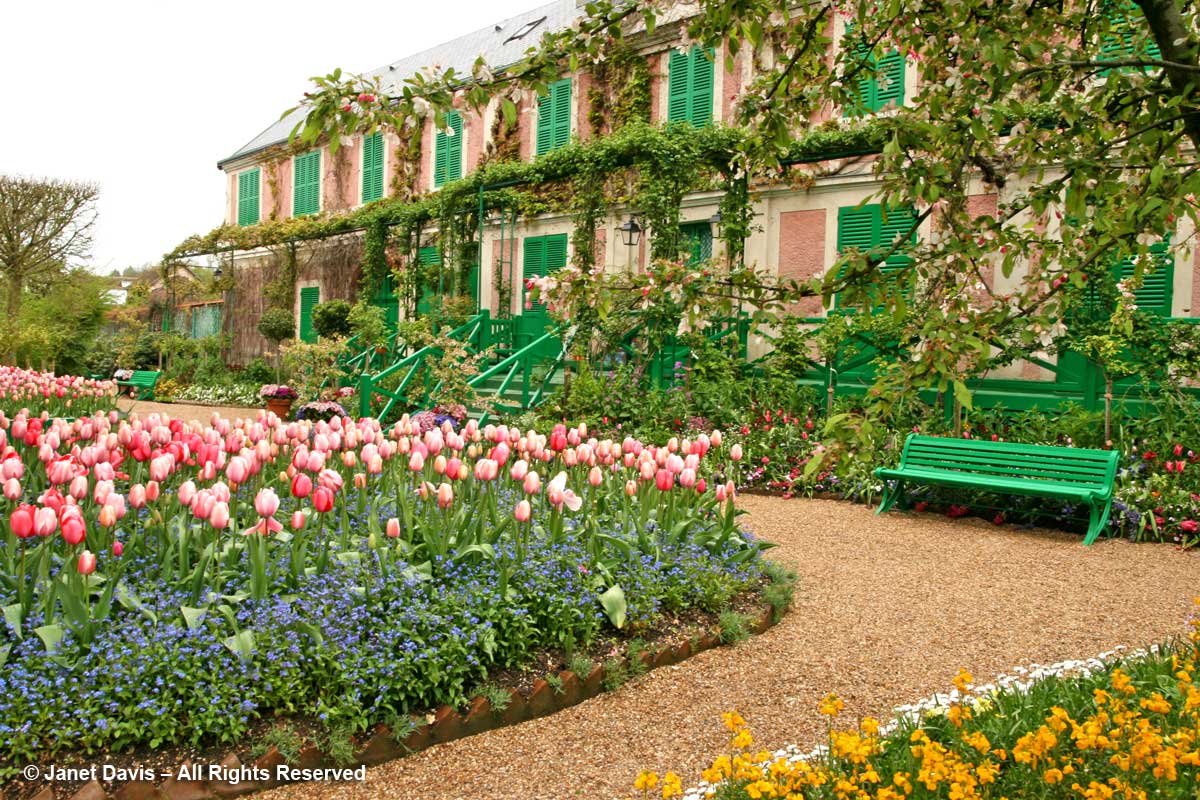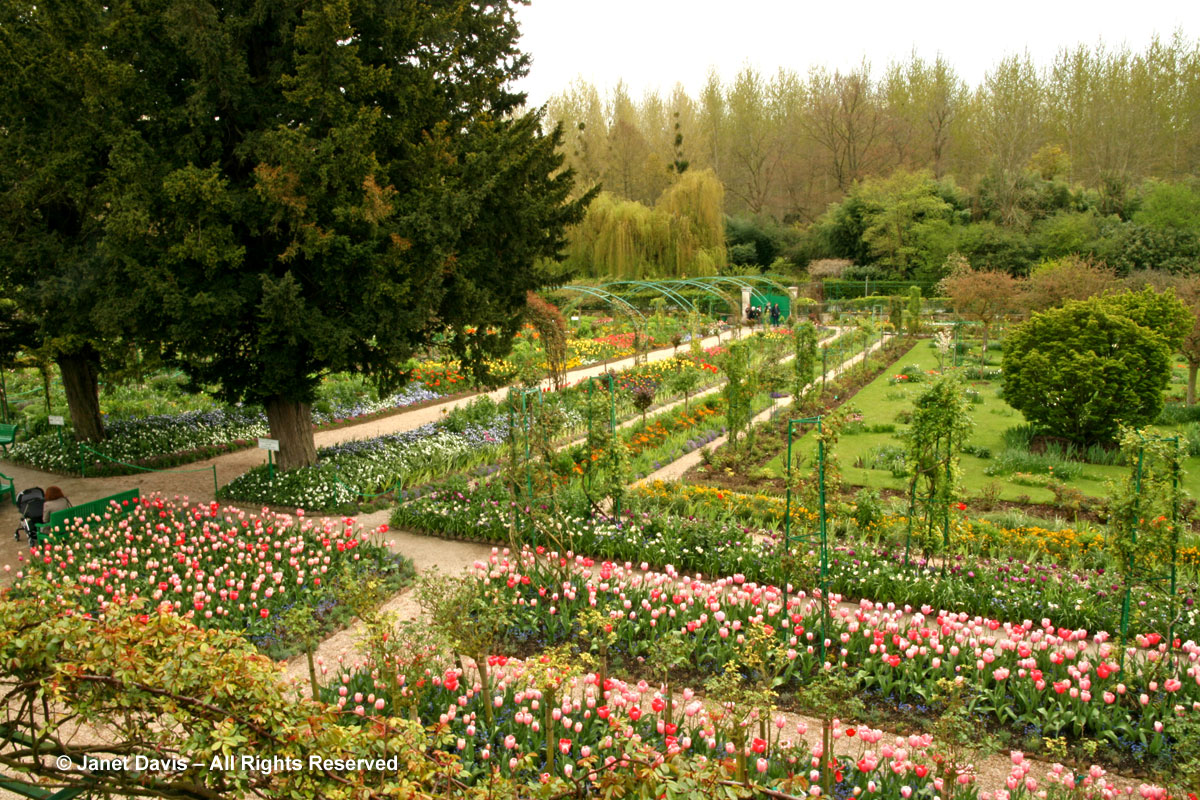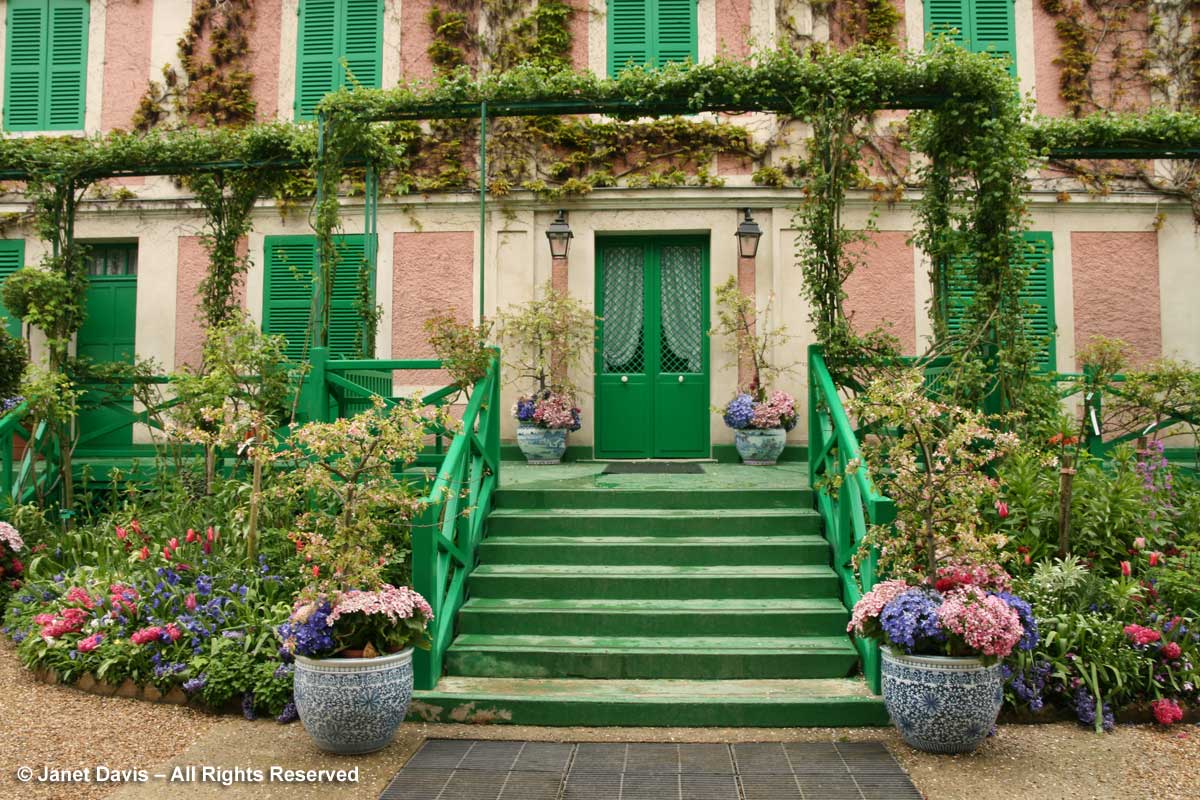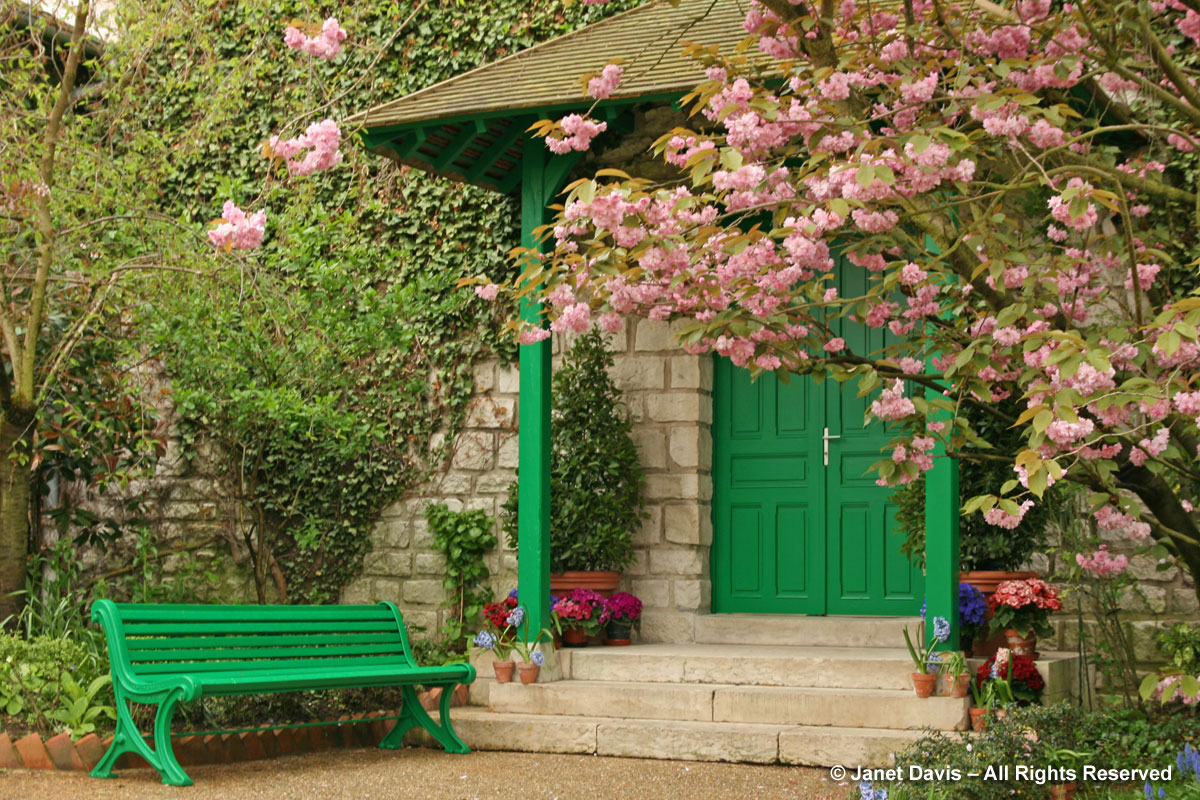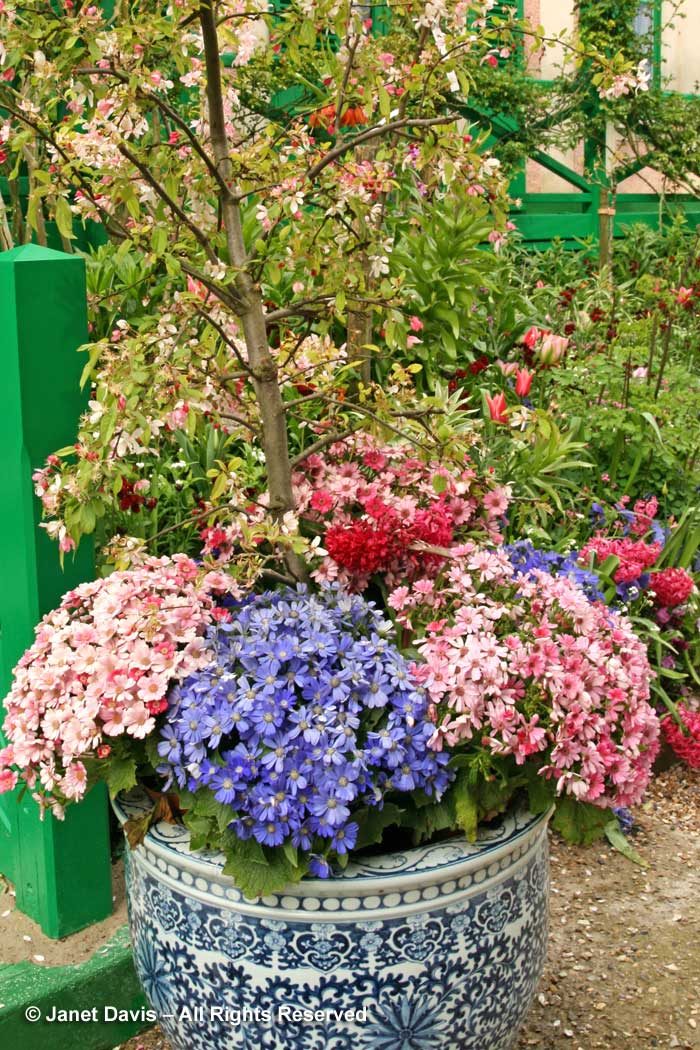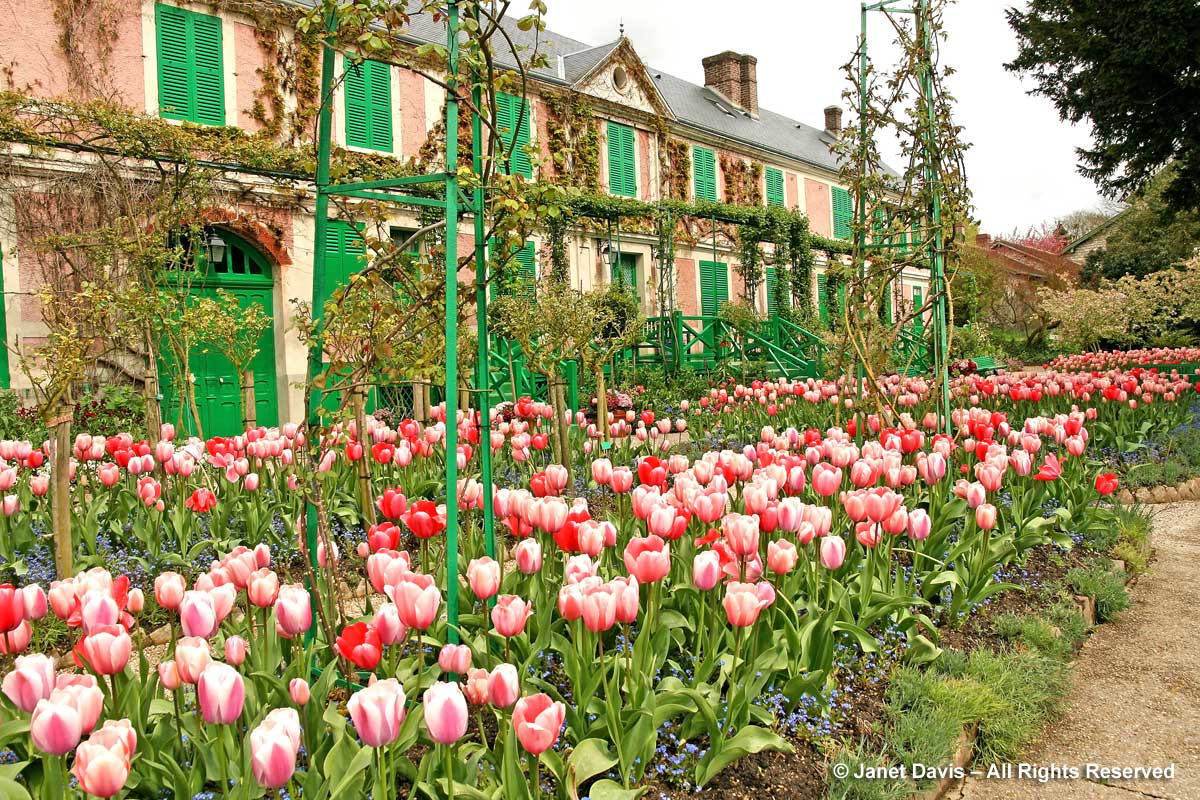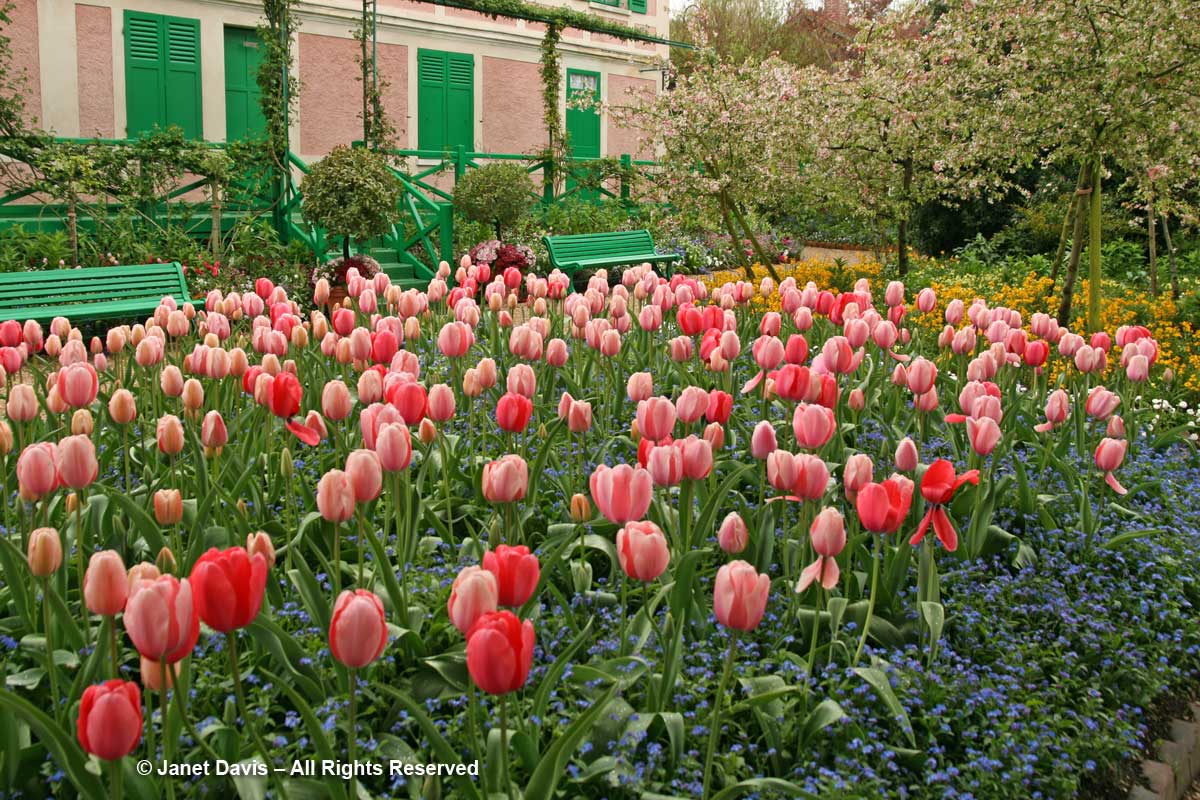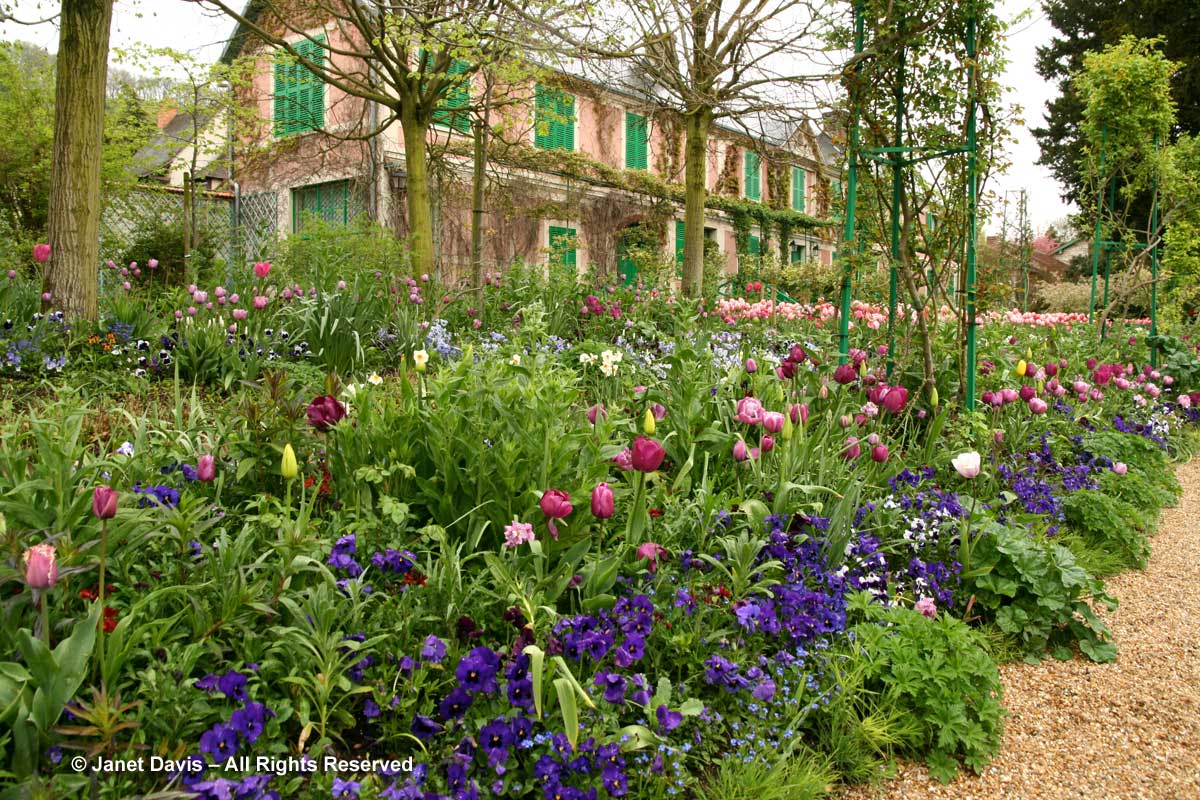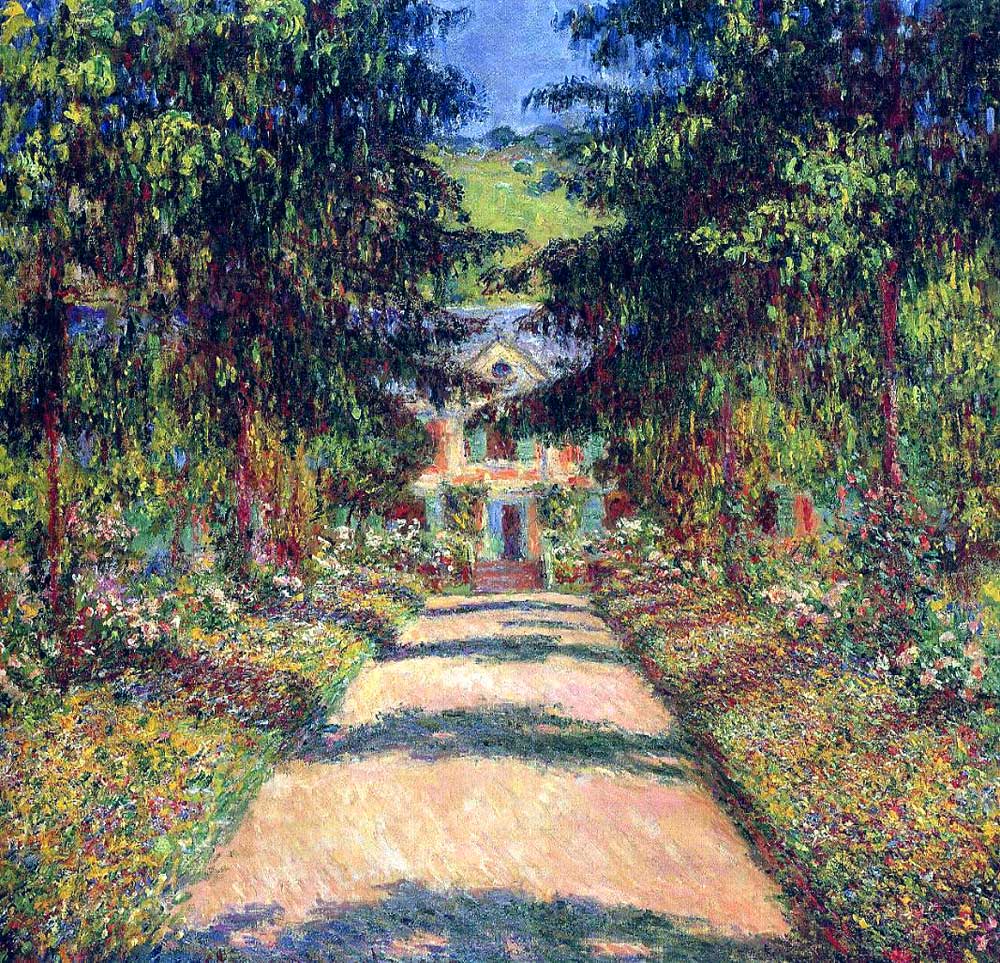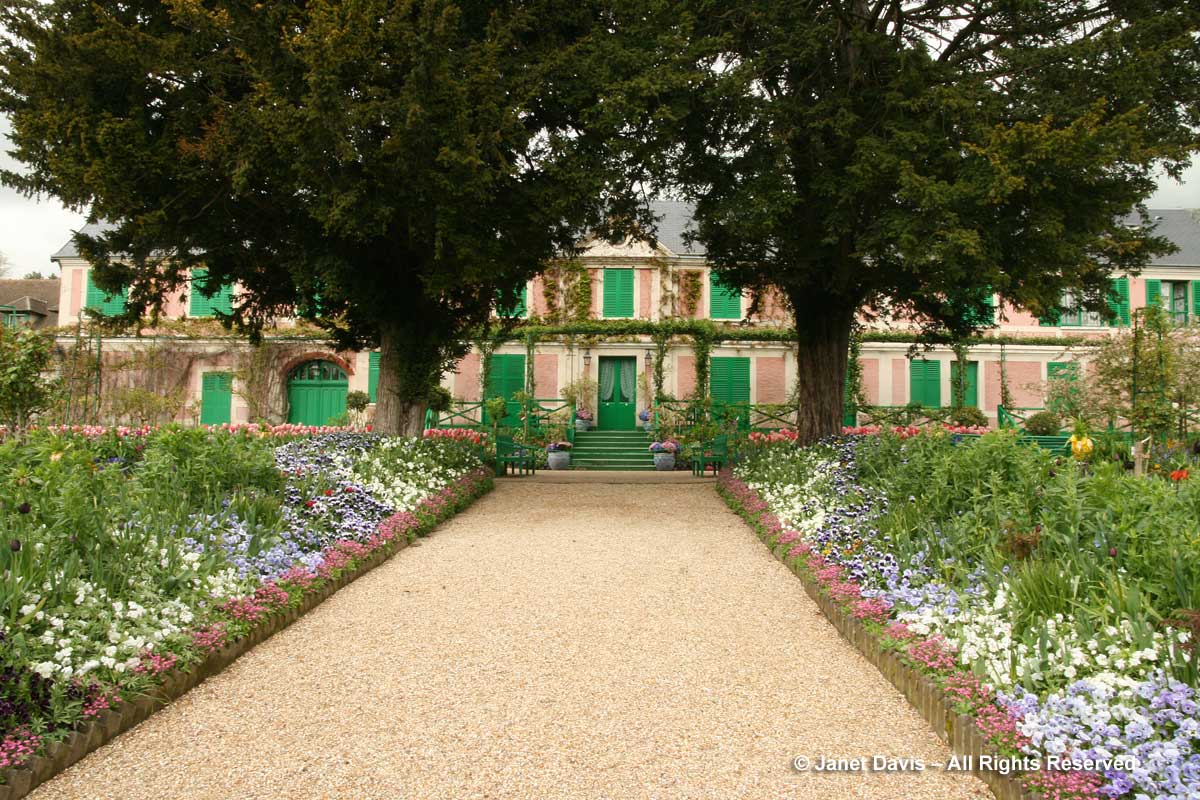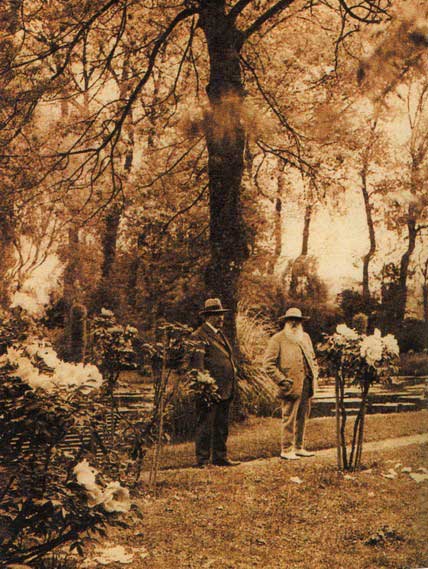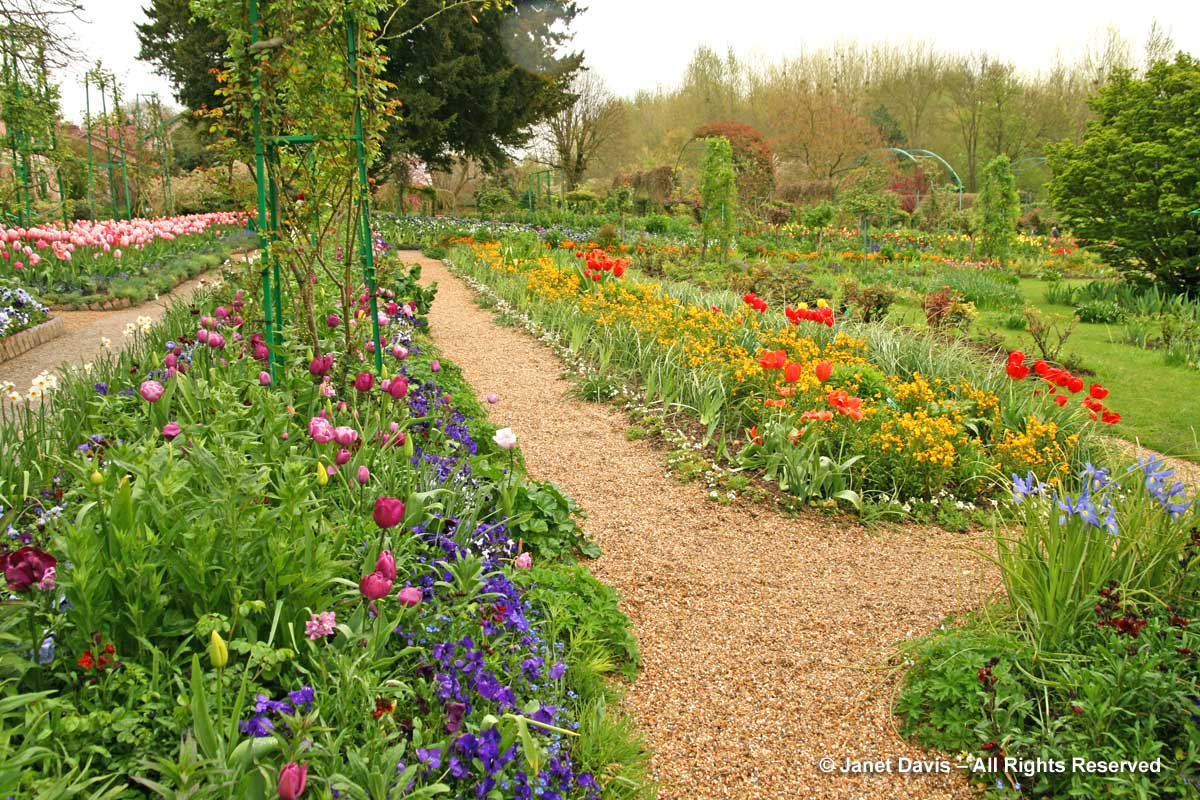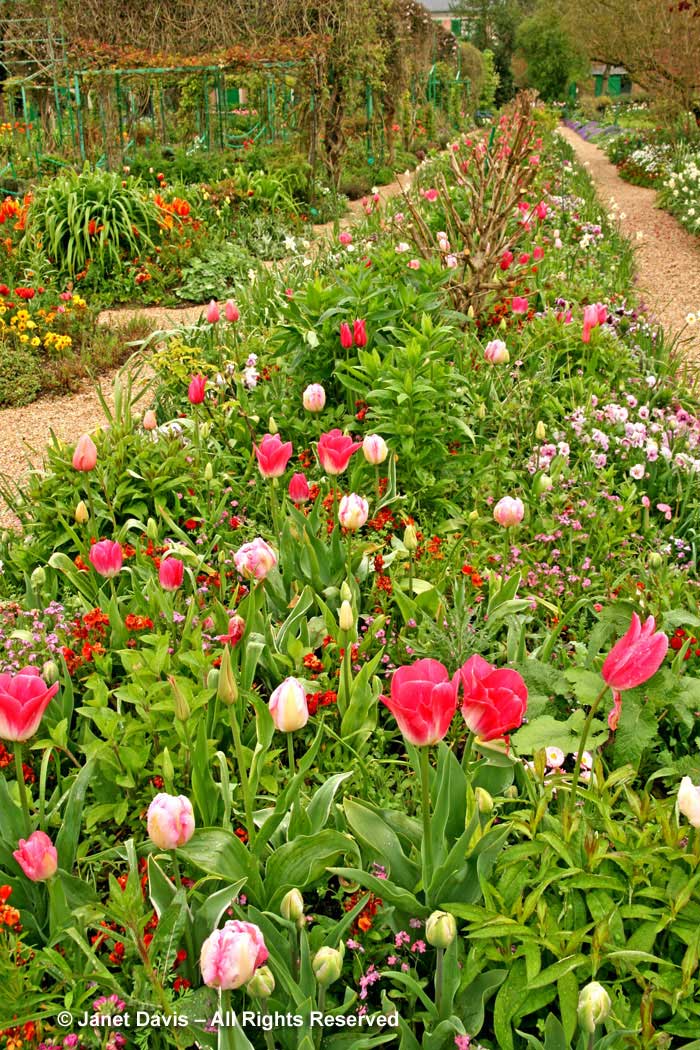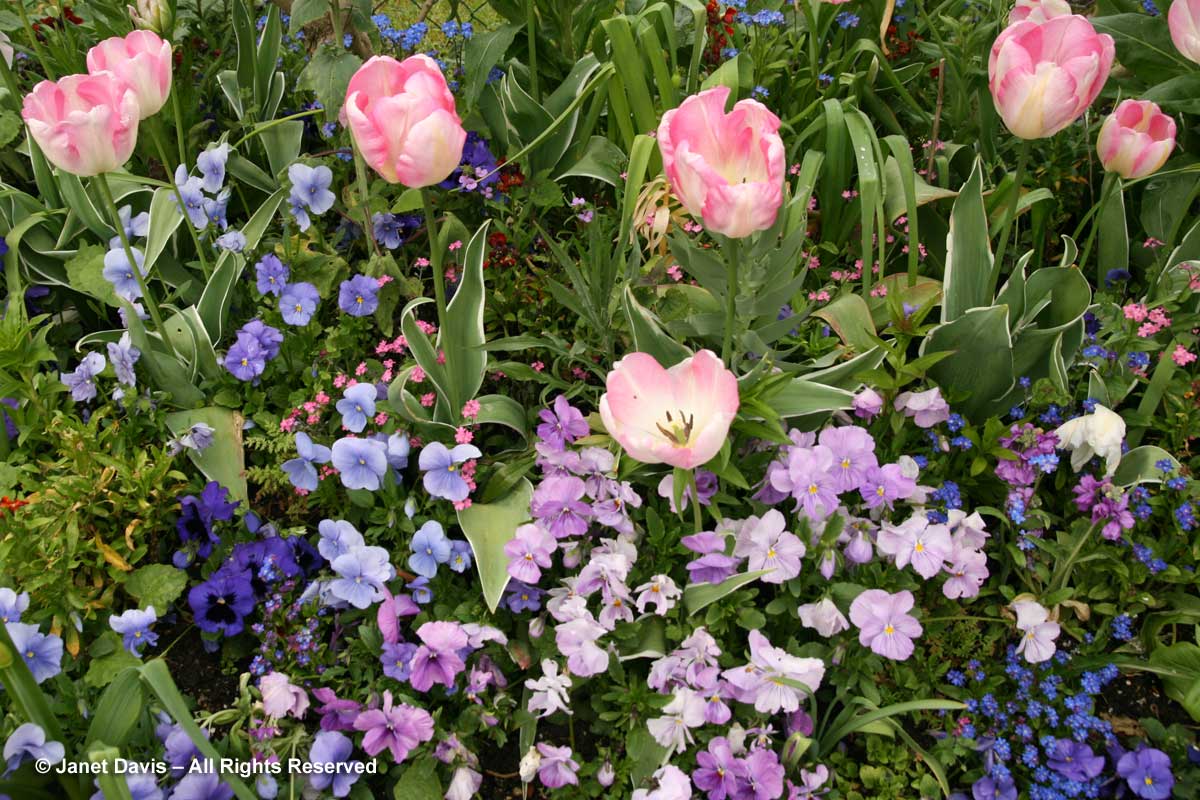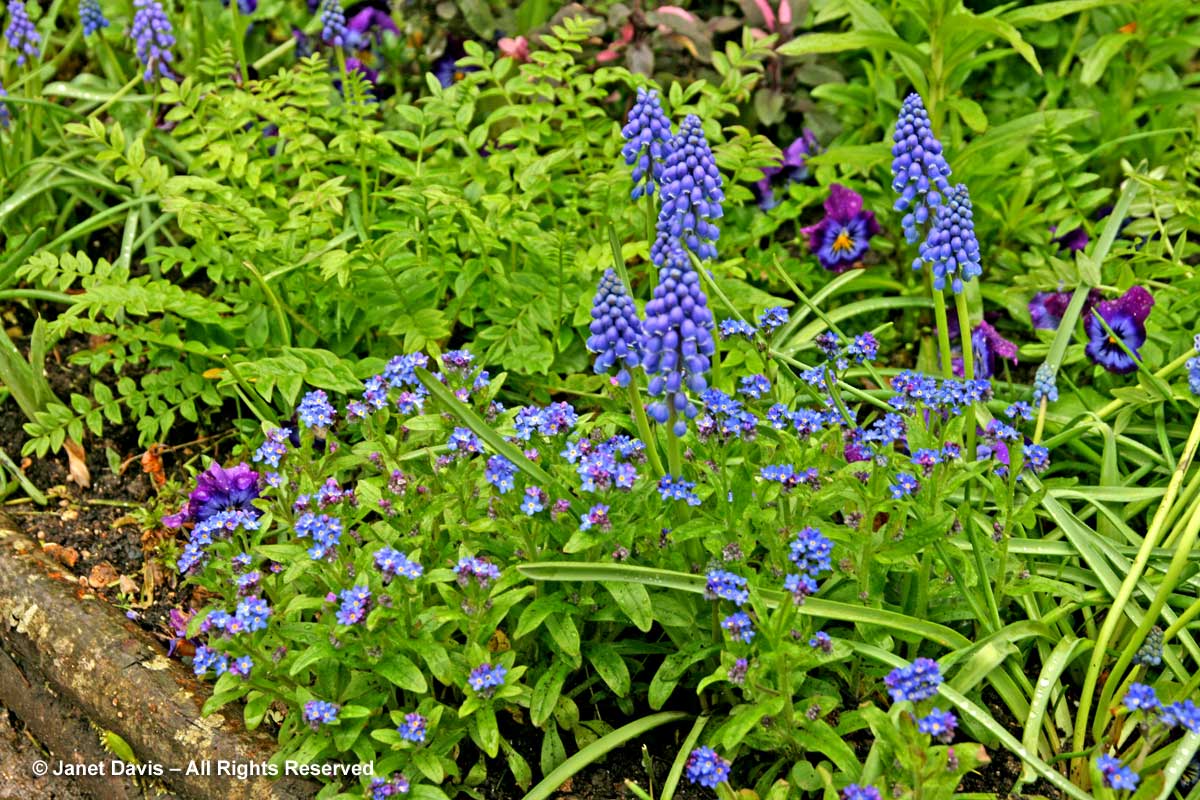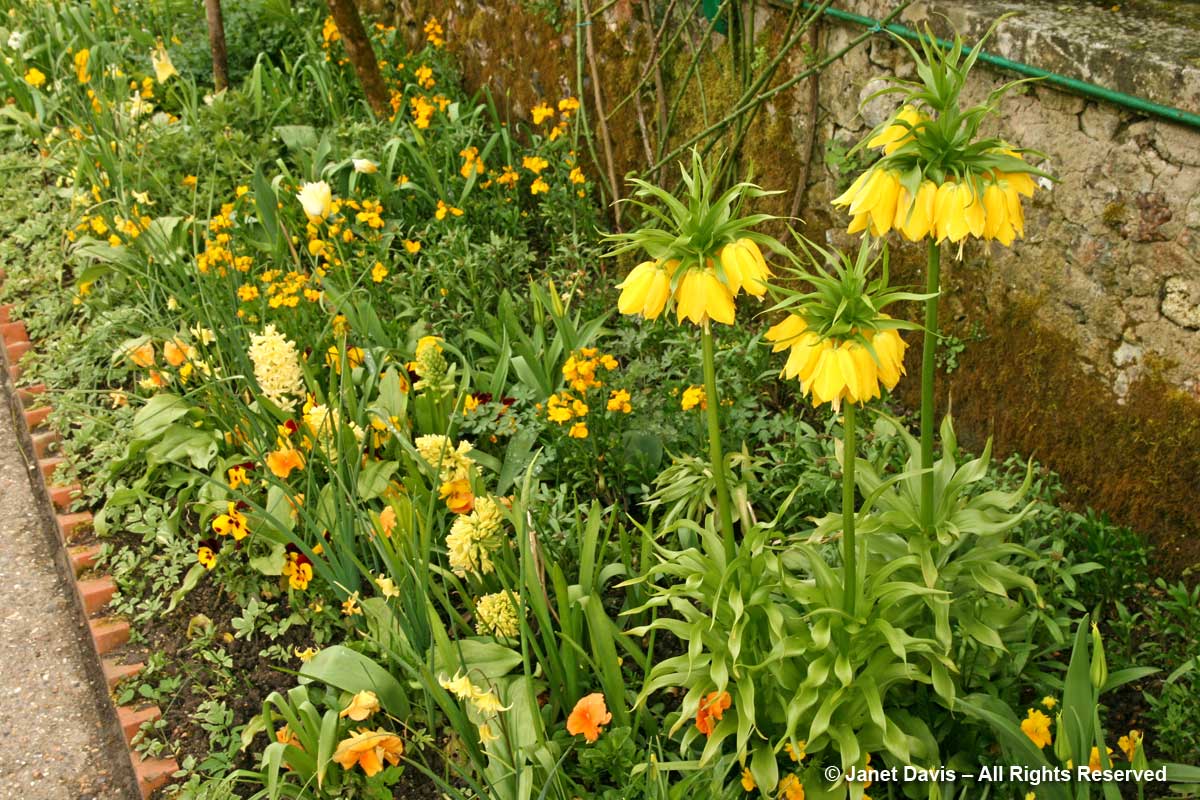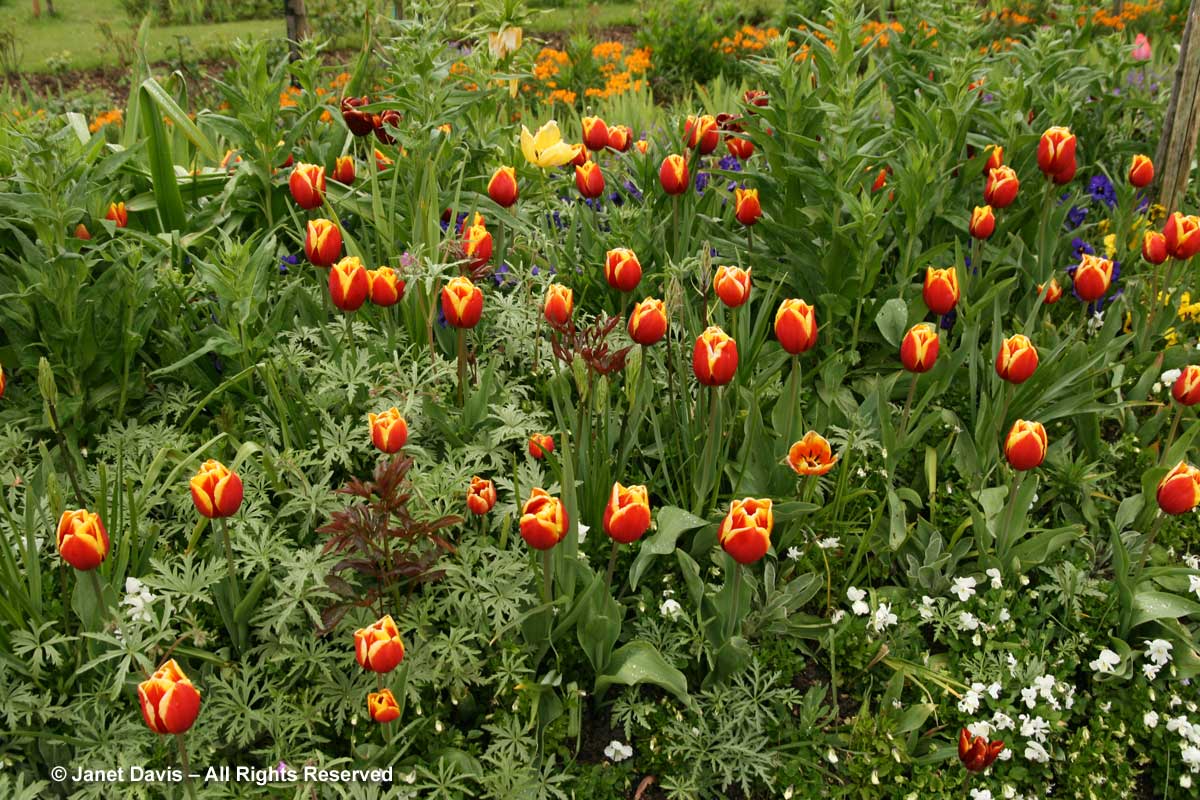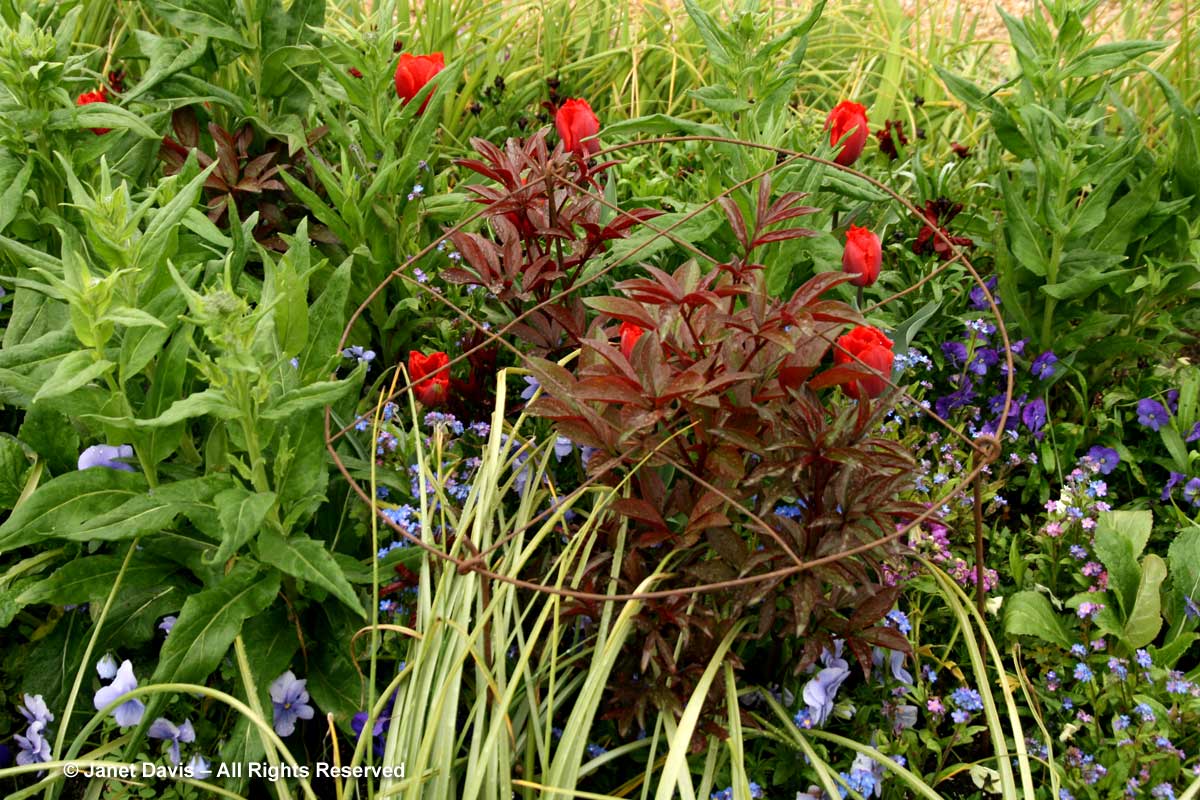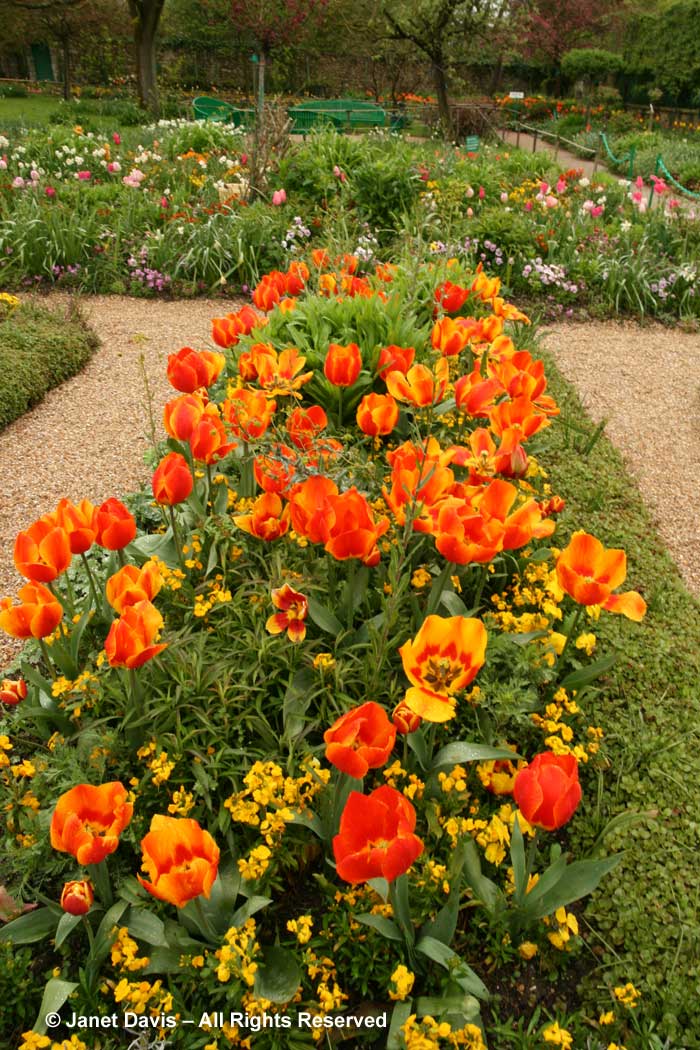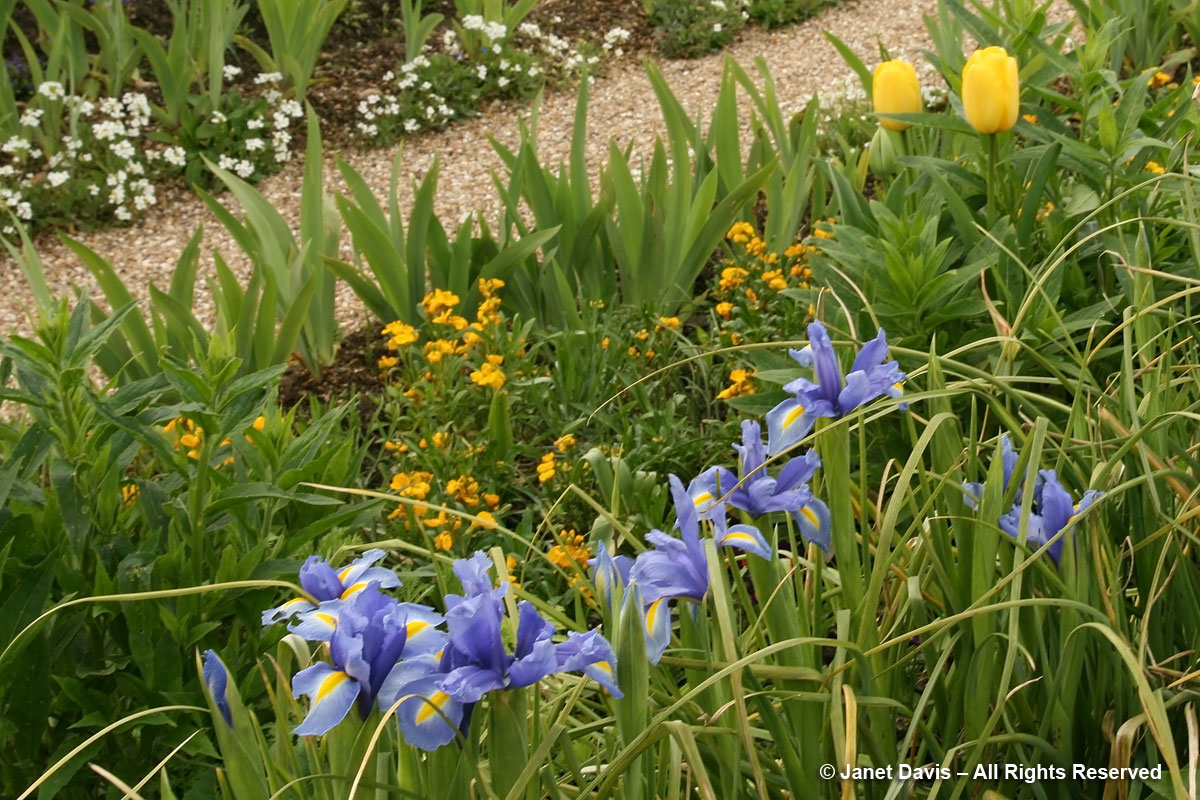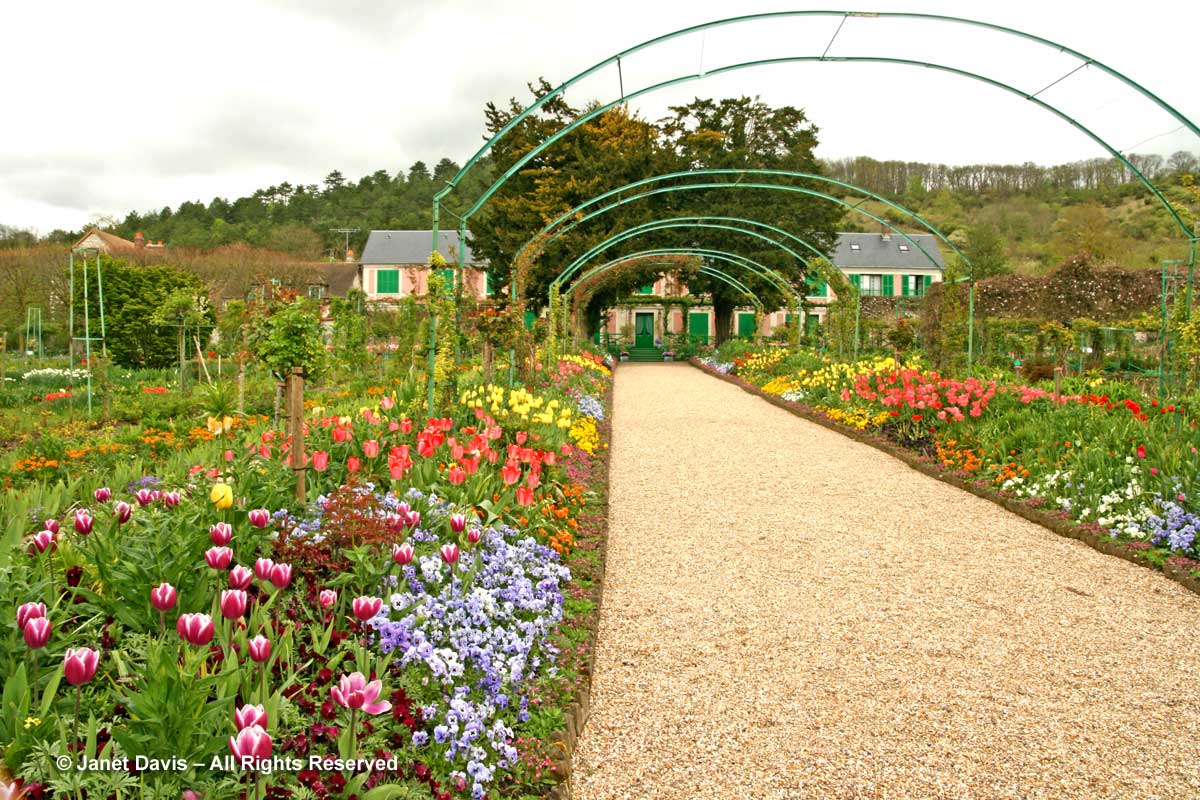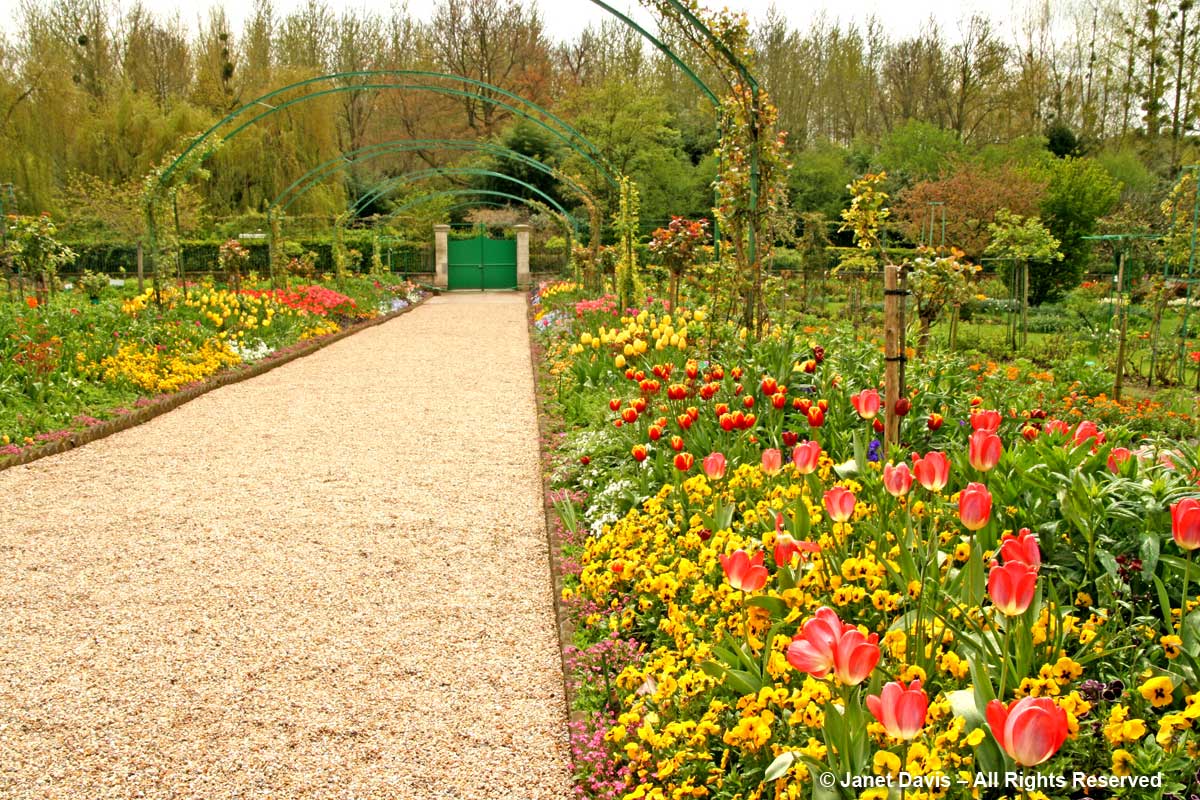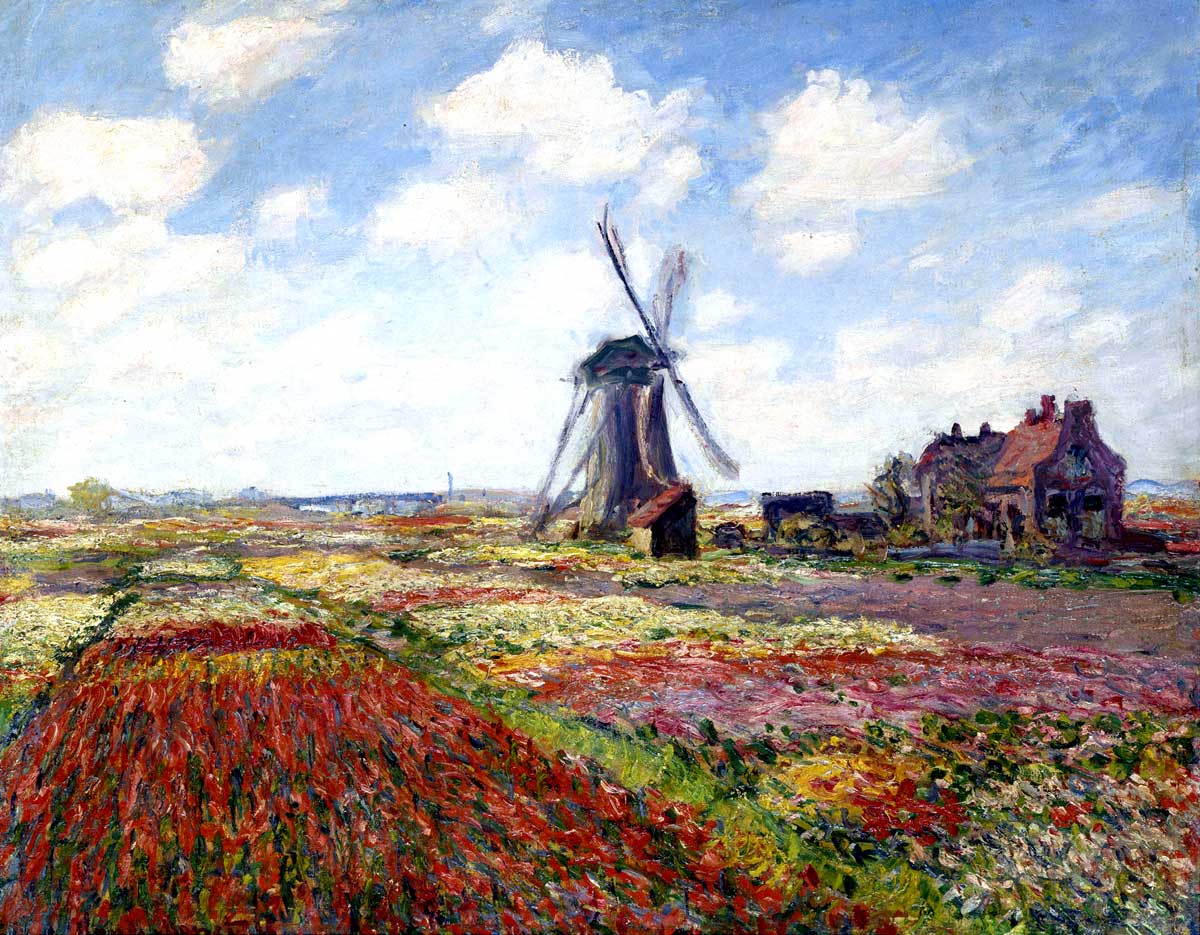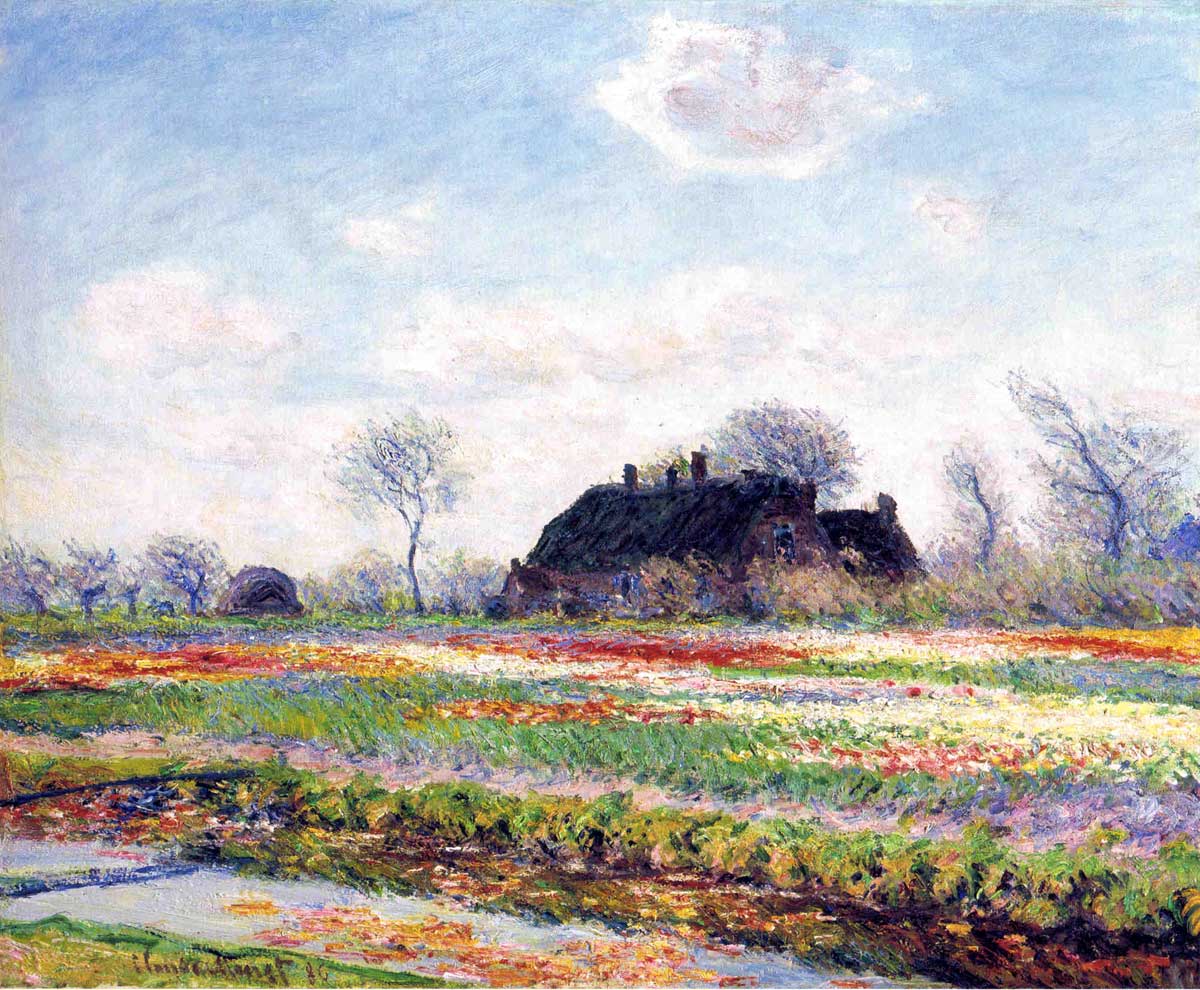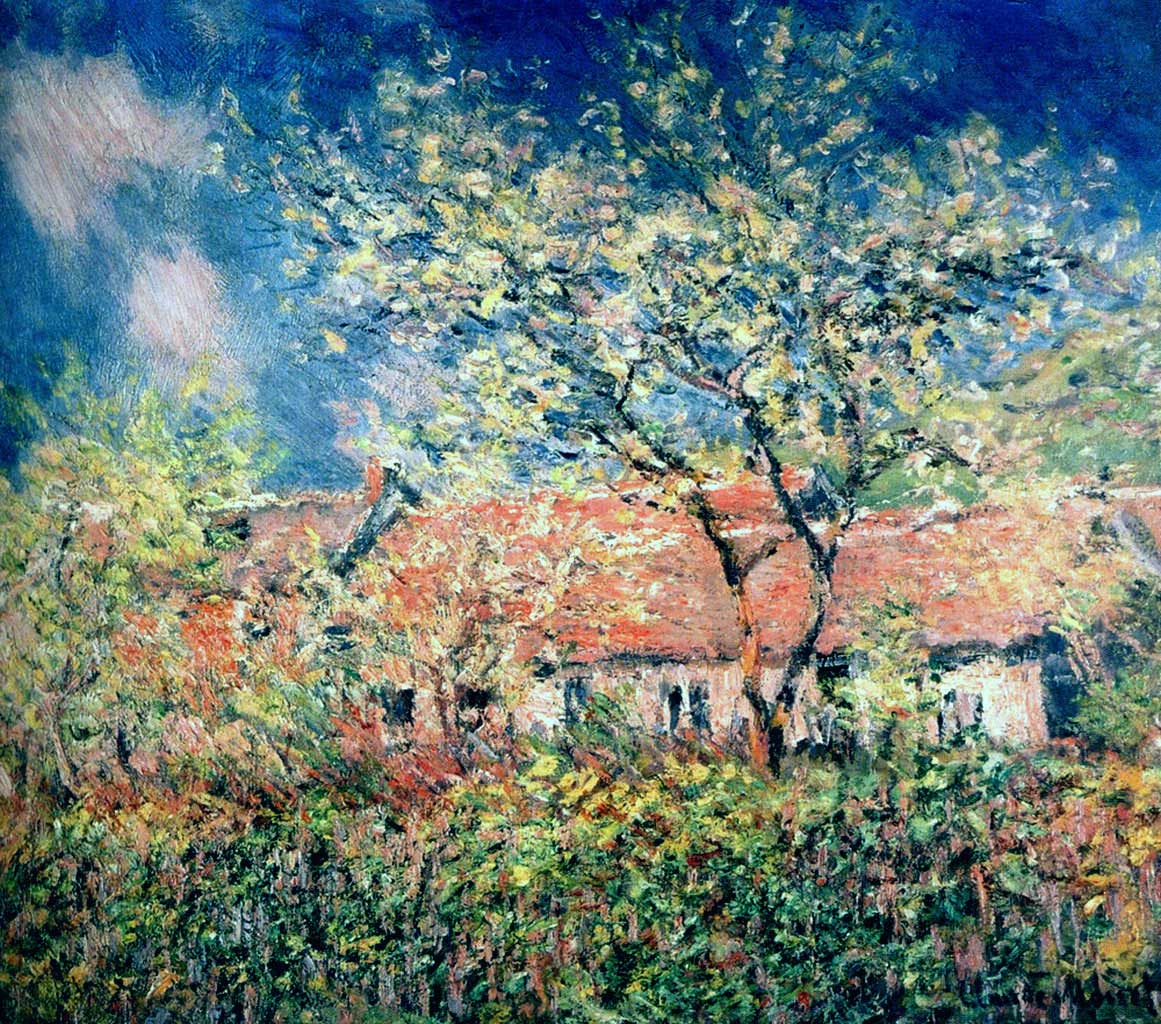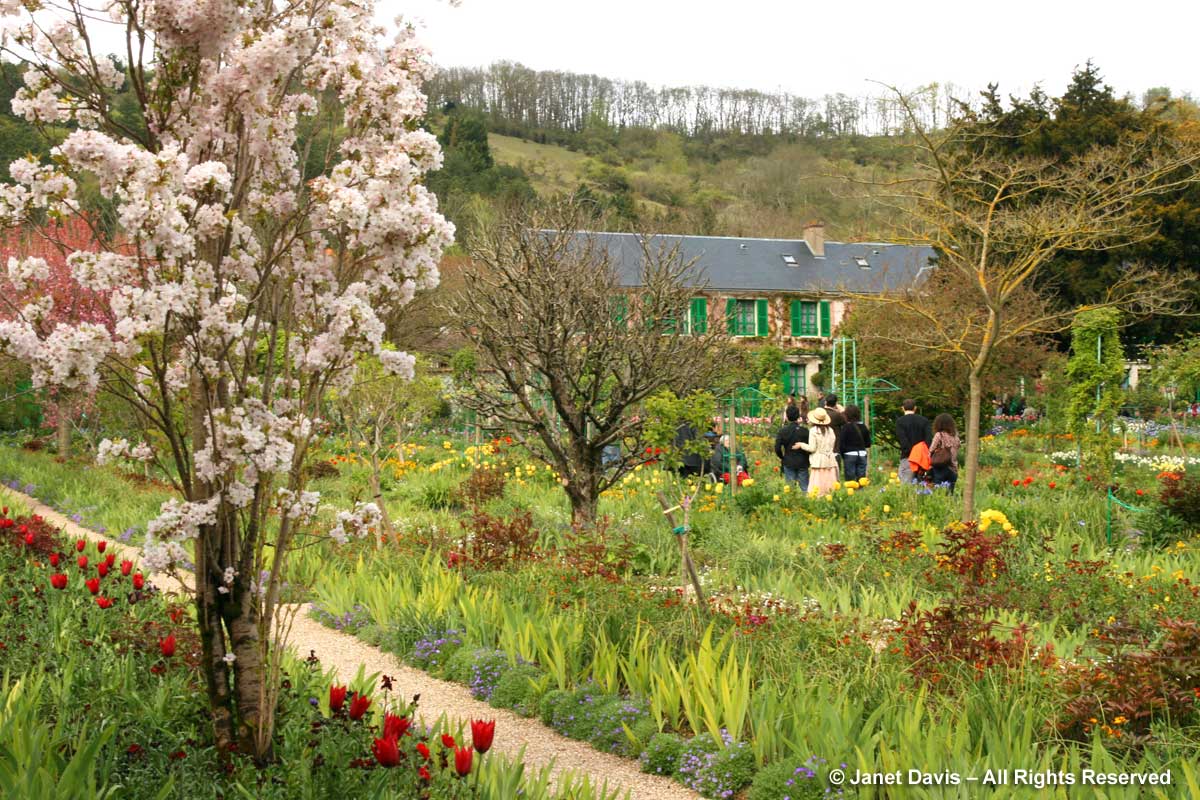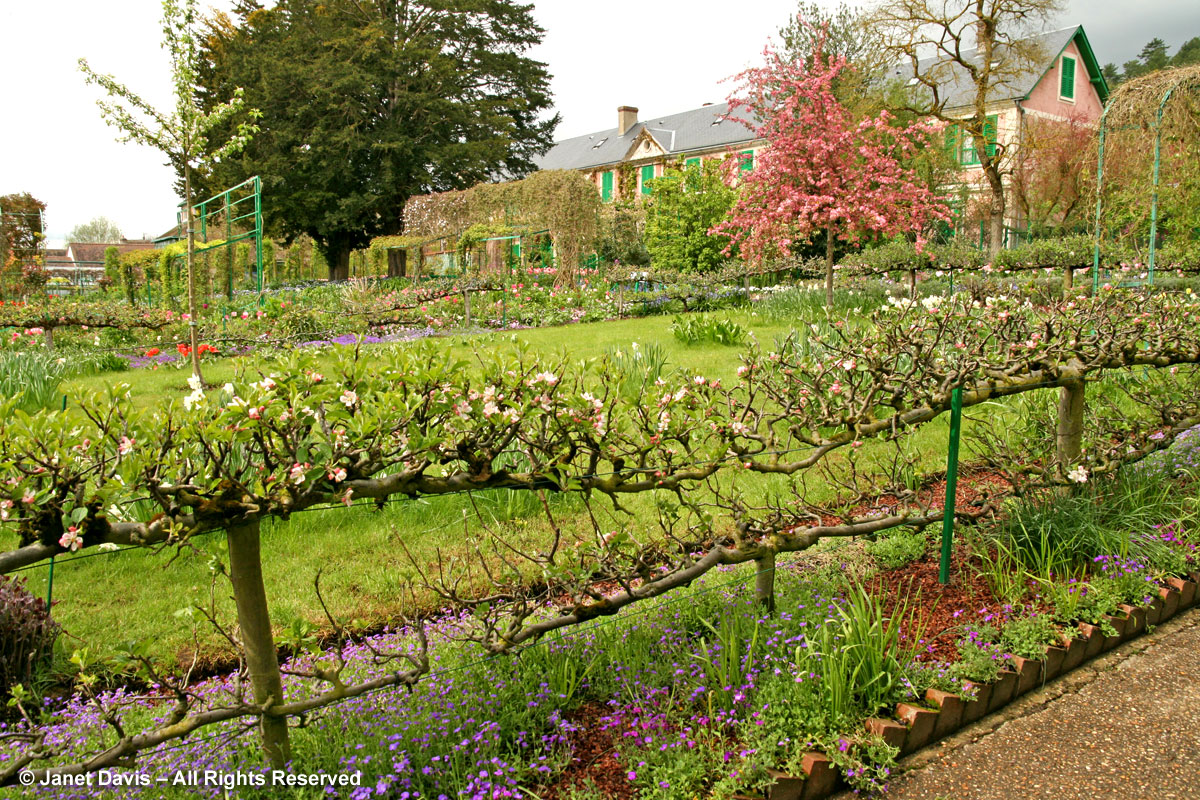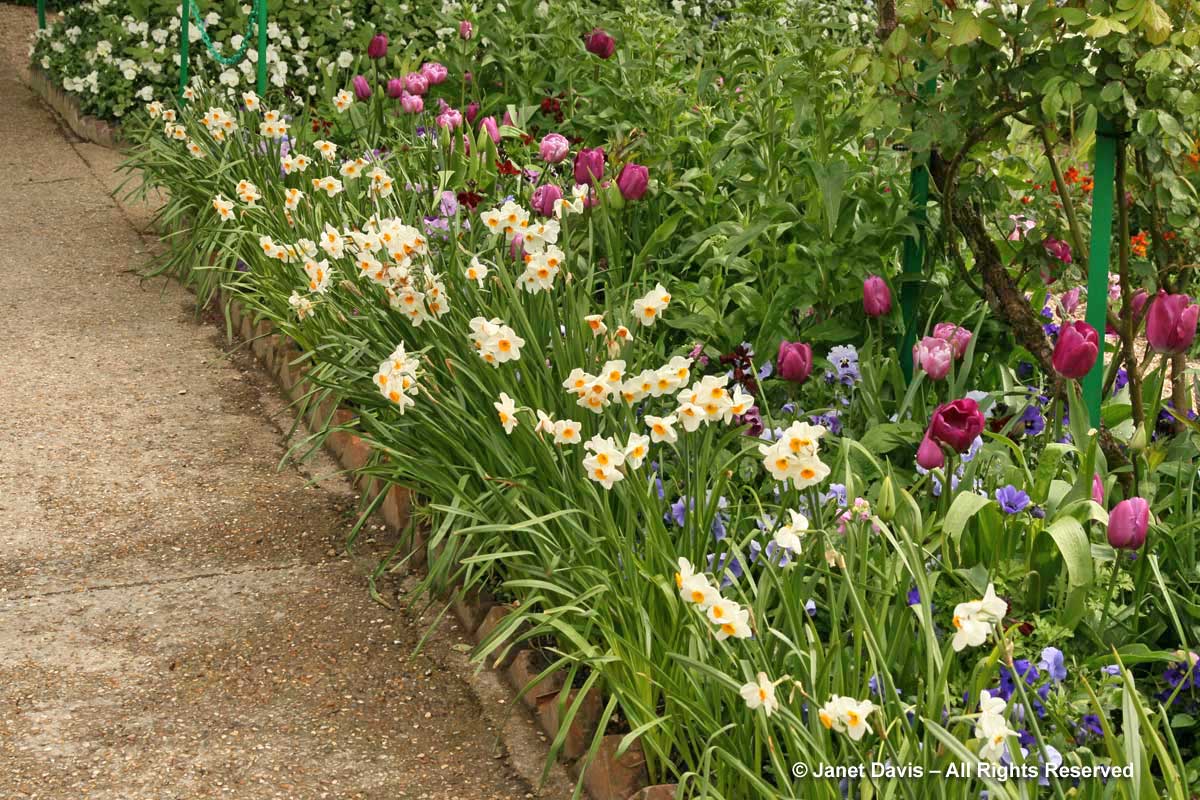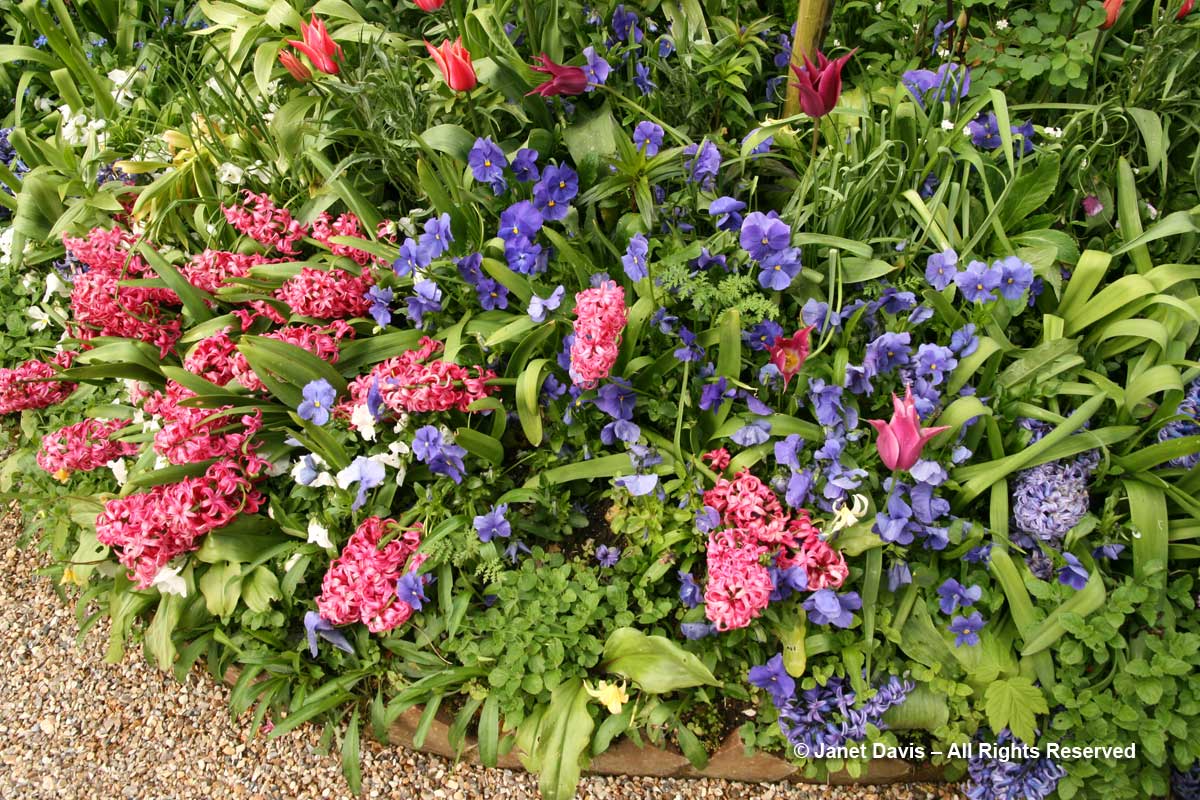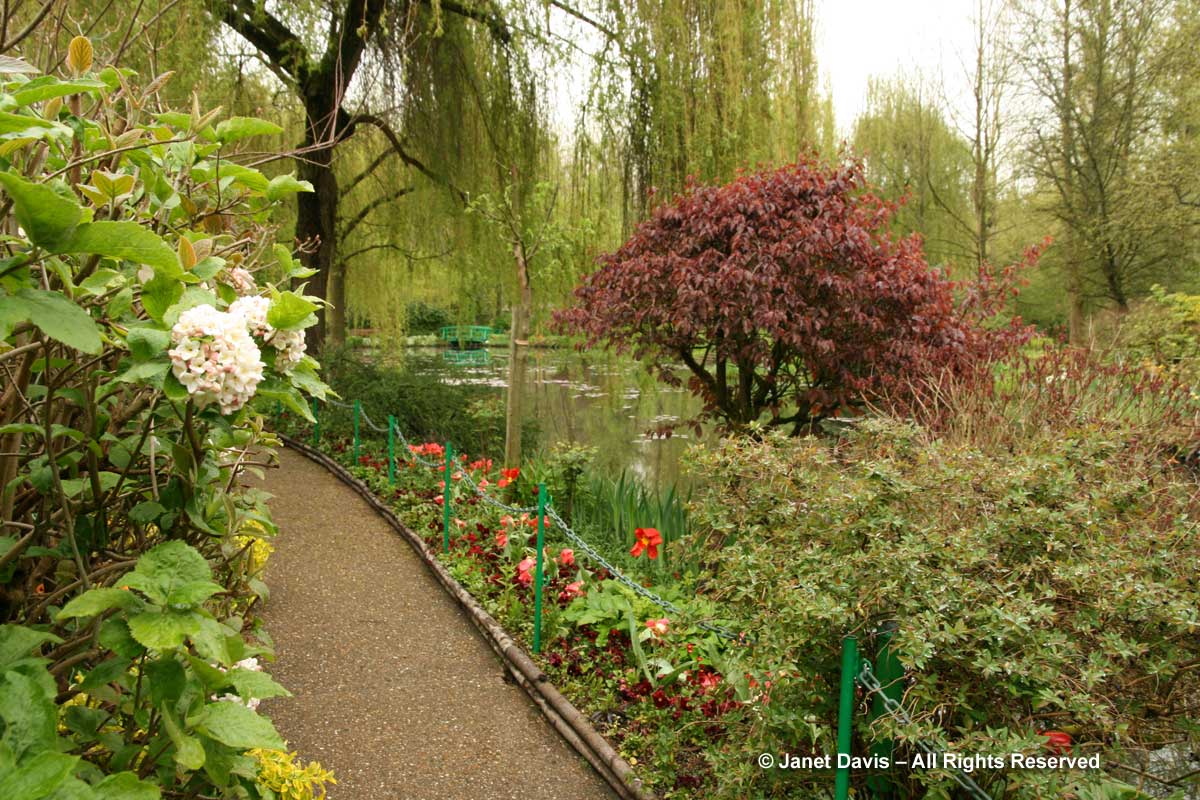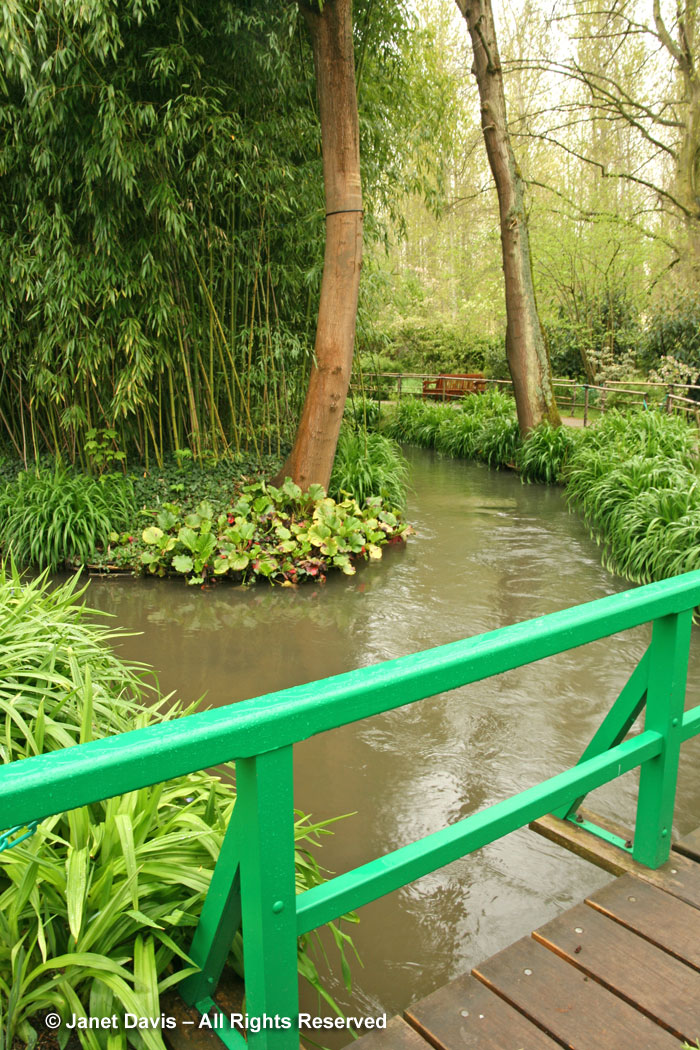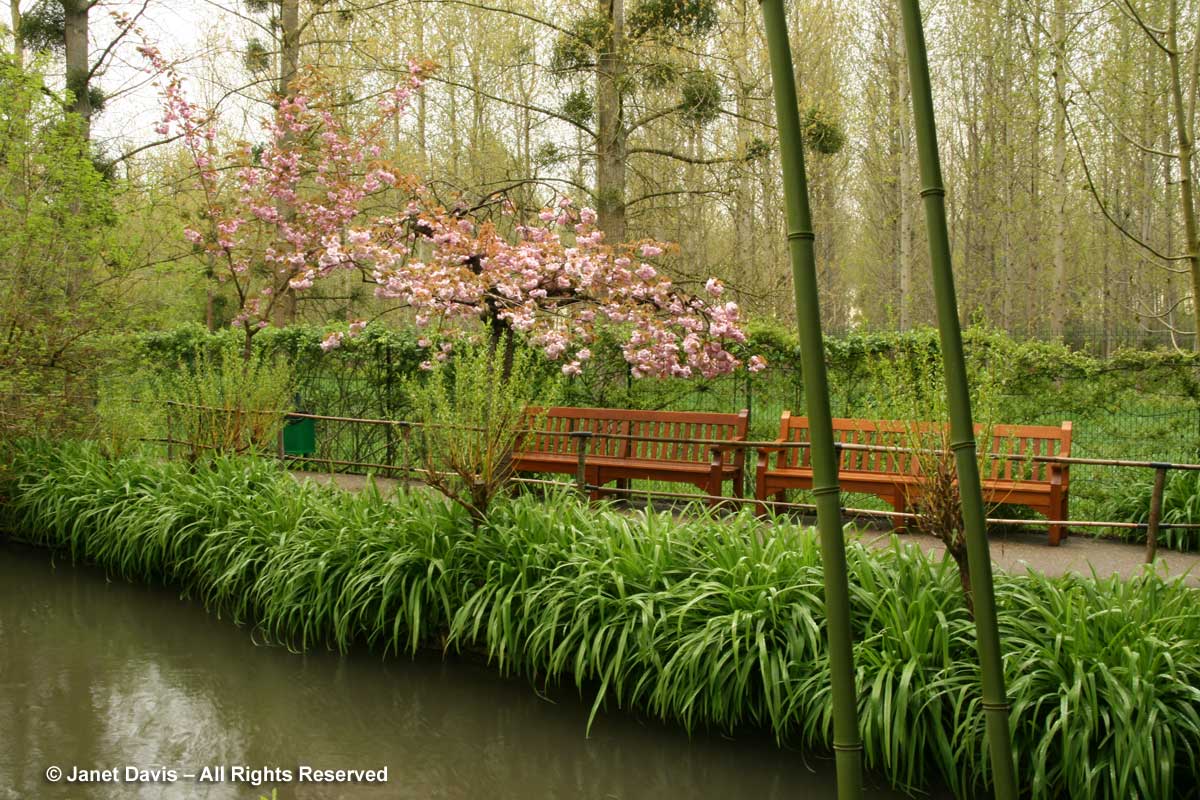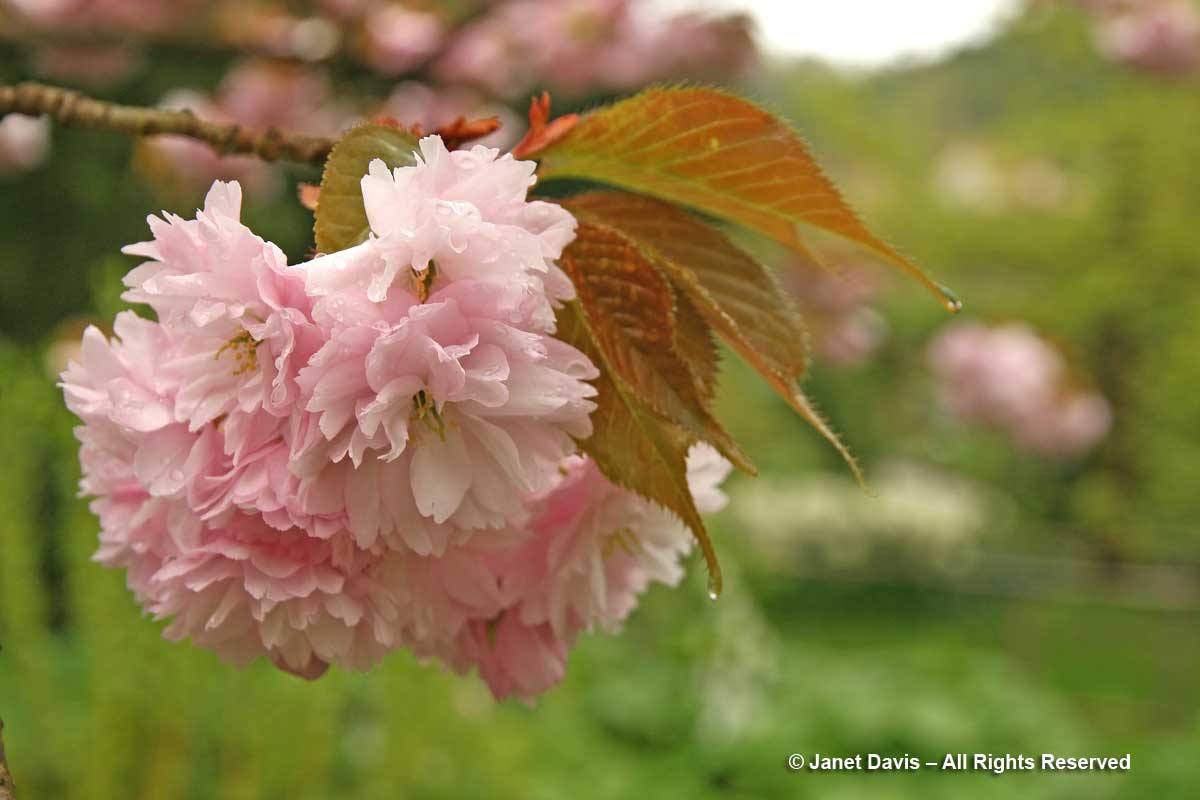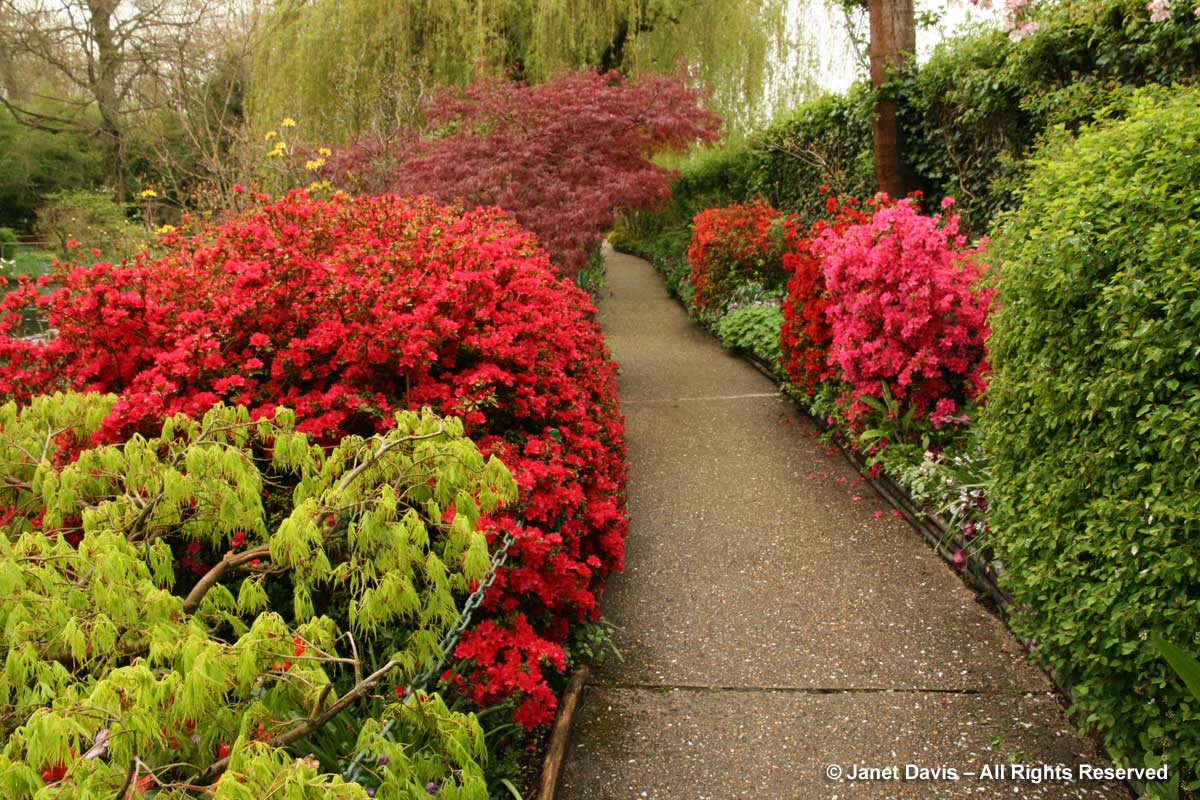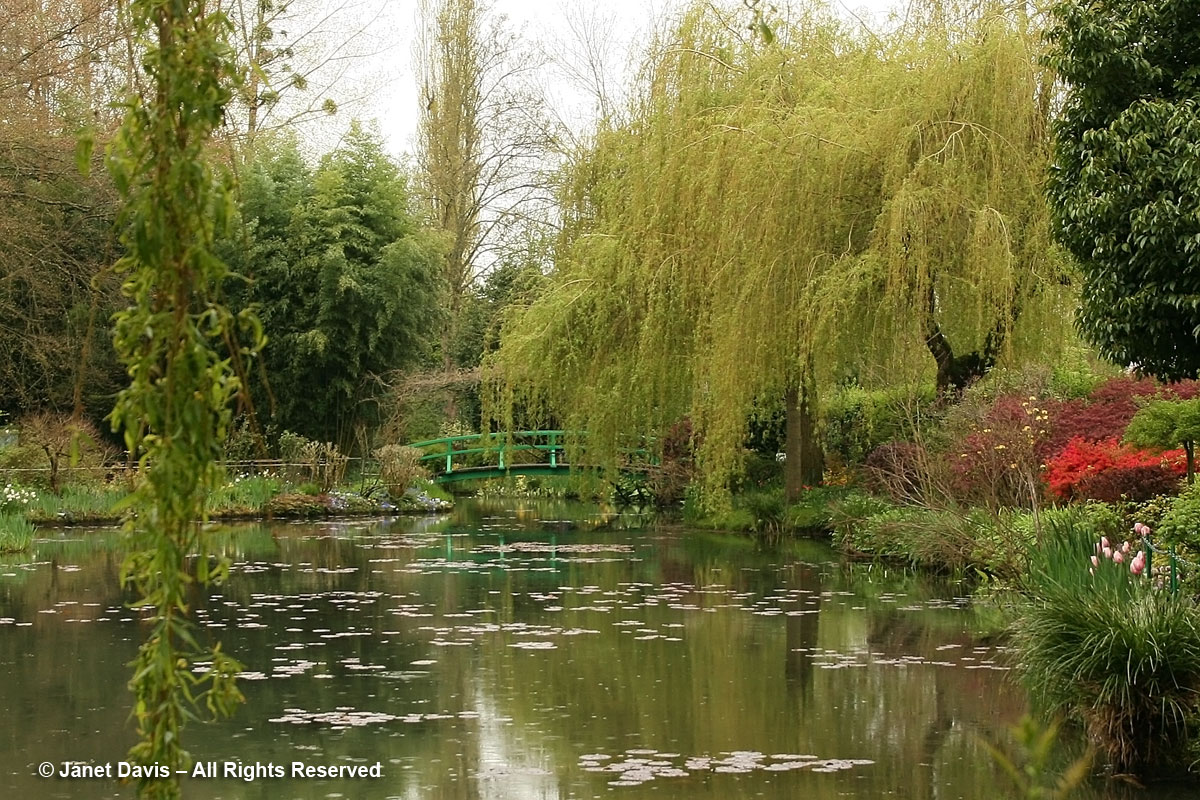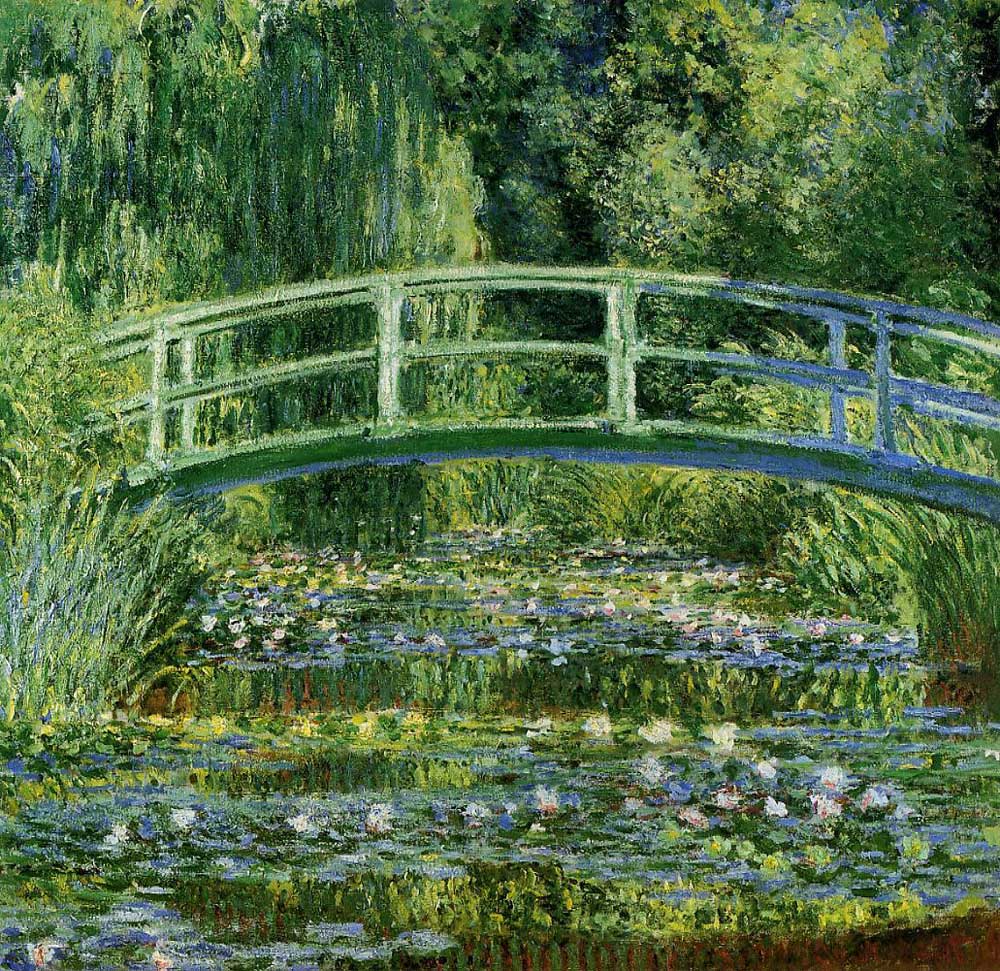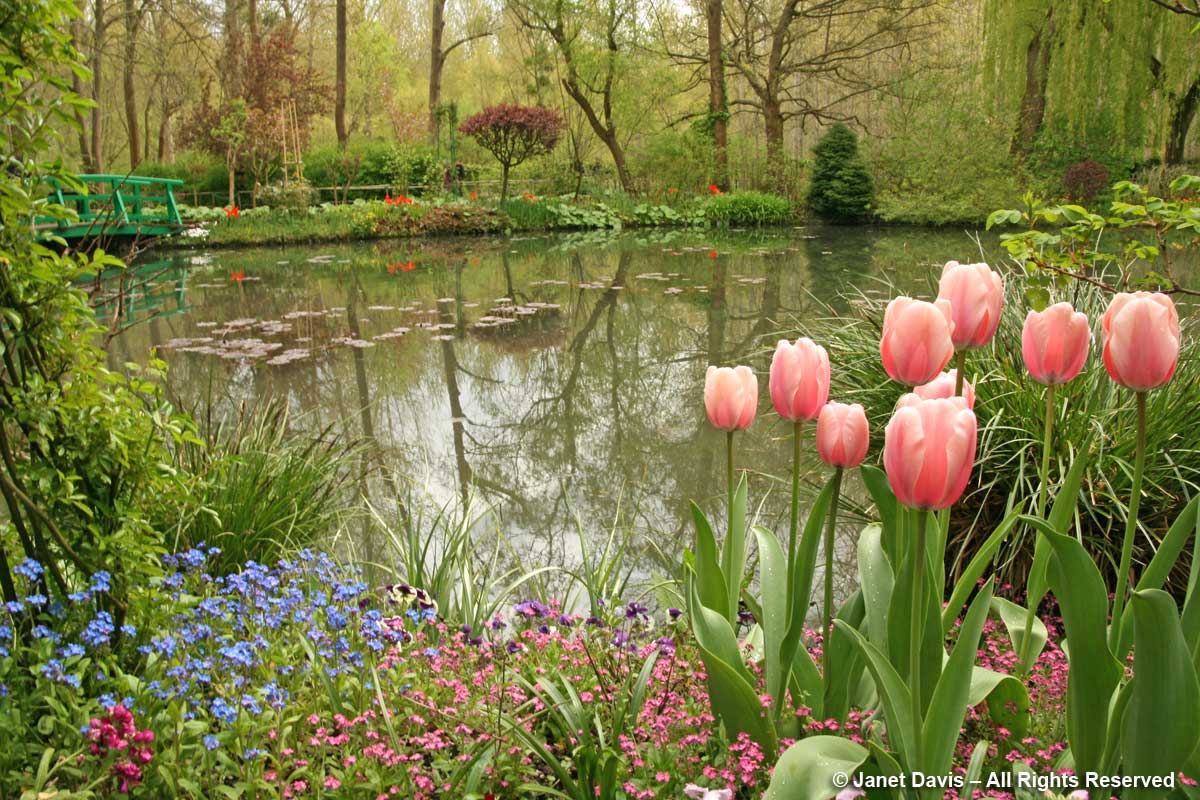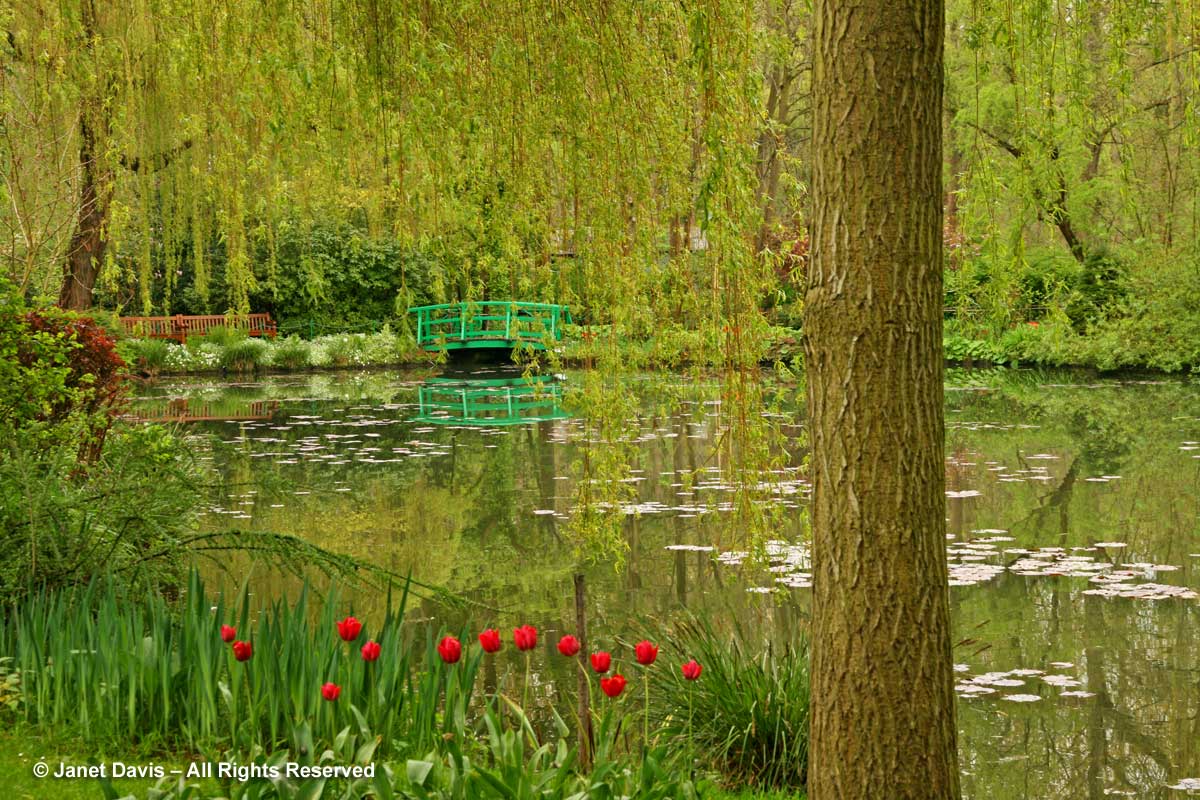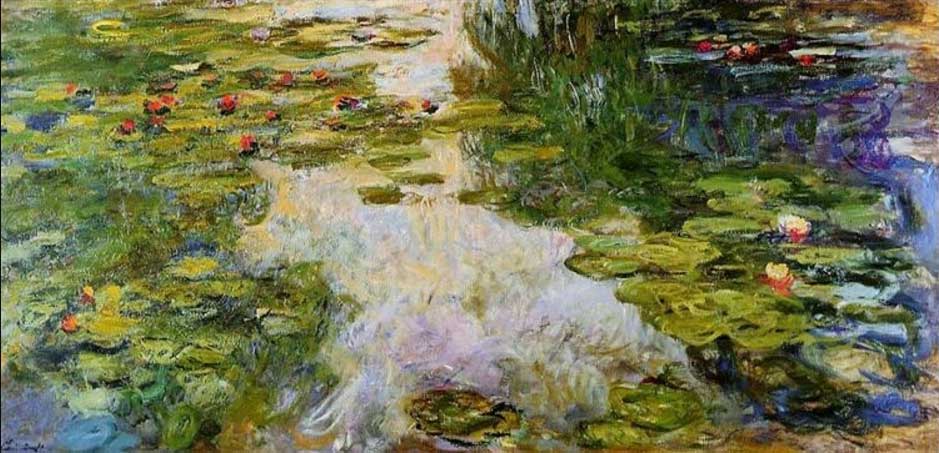Perhaps it’s folly to try to draw inspiration for our own gardens from one of the most famous gardens in the world – an enchanting 5 acres whose renown comes courtesy of its beloved former gardener and owner, Impressionist painter Claude Monet. The garden he made at Giverny is a short bus ride from the town of Vernon in Normandy, which is a 45-minute train ride from Paris’s Gare St. Lazare (direction Rouen). Now home to the Fondation Claude Monet Museum (Musée Claude Monet), the house and garden are visited by some 600,000 people annually.
When I was there a number of years ago, the Fondation allowed photographers and writers to apply in writing to visit on its closed day, Monday. I did so, and stayed in a bed & breakfast in the town of Giverny to be close enough to arrive early Monday morning and walk back to the b & b if it rained (which it did). However, they no longer close during the week and are open daily from late March through October 31st, so everyone must line up for the 9:30 am opening (except those who buy their tickets ahead, allowing them to skip the line). In the summer months, the garden is often terribly crowded and difficult to get around, but on a morning or late afternoon in April, it can be quite delightful.
Interestingly, my photos come from a spring prior to British gardener James Priest’s tenure at Giverny, when the garden’s maintenance was still under the hand of head gardener Gilbert Vahé, who spent 34 years in the garden from 1977 (even before its reopening in 1980) to 2011. However, in 2017, with James Priest now gone, Vahé has come out of retirement to take over the reins once again, presumably to return the garden to some of its well-archived Monet-ness, i.e. “reproduction”, not “adaptation”.
Despite the fact that almost everyone who’s visited Monet’s garden has posted their photos or written a blog, and despite the fact that others think it’s just become too commercial or pretty, I believe that his garden offers some good lessons for all of us. Let’s explore a few.
1. DO NOT BE AFRAID OF COLOUR: My first lesson: Life is short, there are no rules, and a house can be pink stucco, with green shutters and veranda. Why not? Claude Monet, himself a master colourist, retained these colours for the house he first rented, then bought, living in it from 1883-1926. They were faithfully reapplied in 1980, when the house and garden were reopened after a restoration that brought it back to life after more than twenty years of abandonment following the bombing of Normandy during the Second World War. (And, honestly, I thought about working my Photoshop magic on the green paint of the veranda, below, but that’s what more than a half-million visitors will do to the stairs, and who am I to paint Monet’s house?)
2. BRING THE SAME COLOUR PALETTE INTO THE GARDEN: Given that your painted shutters and veranda are colourful, it follows that it’s a very good idea to extend that colour down to painted features in the garden like benches, fences and outbuildings. Not to be ‘matchy-matchy’, but so the eye moves easily from the house architecture right into the garden. This unified approach works whether you’re dealing with taupe or teal – or kelly green.
3. SPRING FOR SEASONAL BLOSSOMS FOR YOUR CONTAINERS: No, it doesn’t have to be a flowering crabapple tree and hothouse cinerarias in a ceramic Chinese pot, like Giverny, but do splurge on some pussy willows and daffodils and primulas to say farewell to winter and rejoice in spring.
4. TRY TONE-ON-TONE TULIPS: Let’s face it; this big bed would be truly boring if Giverny’s gardeners planted it with just one variety of tulip, so they don’t! They mix four cultivars, which the office could not identify for me, other than to say “four”. What that provides is a bit of pointillism that shimmers, rather than a block of colour. If you do this (and you should) make sure the tulips you choose are slightly different shades of a hue, but all the same class, whether it’s Darwin Hybrids, Triumphs or Late-Flowered tulips.
And be sure to remember the importance of humble, biennial forget-me-nots (Myosotis sylvatica) when you’re designing your tulip plantings. Such an easy, beautiful way to carpet bare spring ground.
5. USE PANSIES & VIOLAS: It takes some planning to produce the beautiful combination in the photo below, where purple pansies and violas are in full flower underneath the tulips as they come into bloom. In mild regions like Normandy, pansies have no problem overwintering. But in colder parts of North America, like Toronto (USDA Zone 5-Canadian Zone 6b), pansies should be planted the previous September so they have time to establish roots before winter. That actually coincides with bulb-planting time, so you can fine-tune your colour choices and positioning of the pansies as you tuck in the bulbs. It’s a good idea to add a mulch (use a layer of shredded, damp autumn leaves) once the ground freezes, and choose the hardiest pansies and violas you can find. Try Icicle Pansies which have been bred for cold winter regions. The Delta, Bingo and Maxim series are also reportedly hardy in the north.
6. FRAME A VIEW: There’s a Monet family story behind those big, old yews at the end of the 172-foot long Grande Allée, for they were once the final evergreens in a double line of conifers that hedged this path. They can be seen in one of the many paintings Monet made in his garden, Pathway in Monet’s Garden, 1900, below:
Monet, looking for more sunshine for the flower garden he was making in front of the house, cut all the path evergreens down except this last pair, which his wife Alice Hoschedé-Monet persuaded him to spare. Apart from the grandeur of the yews as a penultimate focal point before the house facade, look at the way the gardeners have used pink forget-me-nots edging that long path to draw your eye to the pink house, creating beauty out of geometry and symmetry.
7. COLOUR WITH PAINTBOXES: When Gérald Van der Kemp arrived in Giverny in 1977 to restore Monet’s abandoned house and property, there was precious little in the way of garden records. With his American wife Florence, he had earlier established the Versailles Foundation in New York, attracting wealthy American donors to fund the restoration of the palace and gardens at Versailles. And it was $2.5 million in further American funding that would pay for the refurbishment of Monet’s house and garden. For details on the garden in Monet’s time, Van der Kemp and gardener Gilbert Vahé sought the assistance of André De Villiers, assistant to Georges Truffaut, the French garden magazine publisher and nursery chain founder, who had visited the garden and Monet often (below).
As well, Alice Hoschedé-Monet’s great grandson, the late artist Jean-Marie Toulgouat still lived in Giverny and was able to provide Van der Kemp with family correspondence, journals and photos. There were also photos made by Claude Monet himself and visitors, as well as letters he had written or that others had sent to him that mentioned the garden.
As to the colour beds in the Clos Normand, we must imagine Monet playing with his paints, choosing felicitous combinations in the same way he might have combined pigments on his easel — which is why these beds have been described as paintboxes. Rather than a riot of colour, they are planted in discrete hues and kept separate from each other, below.
There are pinks….
….and mauves and lilacs….
…. and blues……
…. and yellows…..
….and reds that pair beautifully with the deep green leaves of emerging perennials…..
….and even the colour of the emerging peonies, here shown in the rings used to keep them upright in spring rains.
In Elizabeth Murray’s book Monet’s Passion: Ideas, Inspiration and Insights from the Painter’s Garden (1989, 2nd edition 2010), she wrote: “To increase the various atmospheric effects of the garden, Monet planted rich orange, pink, gold and bronze wallflowers and tulips together on the west side of the flower garden to emphasize the effects of the setting sun.”
“Using blue with clear yellow was one of Monet’s favored color combinations…” wrote Elizabeth Murray, and this pretty pairing of Dutch irises with yellow wallflowers and tulips illustrates the wisdom of that choice.
But it’s in the arrangement of the solid blocks of brilliantly-coloured tulips in the Grand Allée, looking under the rose arches towards the house…..
…..and to the bottom of the Clos Normand…..
….that we see the closest intimation of the paintings that Monet made in 1886 after visiting the bulb fields of Holland. Here is Tulip Fields With The Rijnsburg Windmill (1886)….
…and Tulip Fields at Sassenheim (1886).
It’s these powerful reminders of Monet’s art that makes the garden resonate for me.
8. PLANT FLOWERING TREES: Every garden needs trees with spring blossoms – Monet appreciated this, and painted the garden when his trees were in bloom, as in Springtime at Giverny (1886), below:
Whether ornamentals, like the many lovely Japanese cherries, including slender Prunus serrulata ‘Ama-no-gawa’, shown below in the Clos Normand……
….or edible fruit trees such as pears, plums and apples – like the beautiful espaliered apple trees trained as fencing around the lawn, below, spring-flowering trees play a structural role in Monet’s garden.
9. REMEMBER FRAGRANCE: It’s a simple lesson, but one that we often forget. Scented flowers should be planted where we can appreciate their fragrance. At Giverny, that means a row of Narcissus ‘Geranum’ edging the path…..
….. or a tumble of hyacinths planted where we can inhale their sweet perfume on the wind….
…… or a truss of fragrant snowball viburnum (V. x carlcephalum) at nose height as we pass by.
10. GARDEN THEMATICALLY: Claude Monet became passionate about Japanese arts and crafts. His large collection of woodblock prints by Hiroshige, Hokusai and Utamaro is still displayed on the walls of his house. And in the garden, he turned to the Japanese landscape school to inspire him in creating his famous lily pond. We see the Japanese influence especially in the presence of the bamboo…..
…daylilies……
….. ‘Kanzan’ flowering Japanese cherry, below, and other Japanese flora in the area…..
…including the brilliant azaleas and Japanese maples on its shore.
10. PLAY WITH A POND: For many visitors, the lily pond at Giverny offers the most intimate connection to Claude Monet, given that the wisteria over the Japanese bridge (like the waterlilies, not in bloom here) is the original vine and the bridge itself……
….still looks much as it did in Monet’s The Japanese Footbridge, painted in 1899.
And, of course, there were his many paintings of the famous nymphaea or water lilies, some of which I saw in 2016 in a magnificent show called Painting the Modern Garden: Monet to Matisse at London’s Royal Academy of Arts
But any pond needs context and perspective and a connection with the rest of the garden, and in this respect, Monet’s pond offers other good lessons. The edges are planted to offer foreground interest no matter where visitors stand…..
…. and the weeping willow lends an air of mystery, its long branches cascading to suggest a gauzy screen.
Standing beside the pond, it’s easy to imagine Monet here with his easel — something made easier considering there is video footage of him painting his famous water lilies here at the pond’s edge.
As we leave the pond and Giverny, it seems appropriate to conclude with one of Monet’s masterpieces, painted exactly 100 years ago, its genius that quixotic alchemy of sunlight, reflection, water and flora which, his vision failing, he strived to perfect for the last three decades of his life. I give you Water Lilies, 1917.

